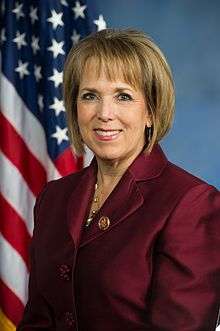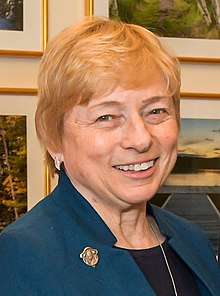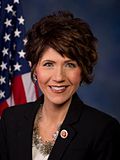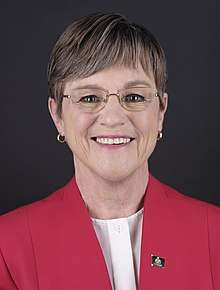Women in government
Women in government are underrepresented in most, if not all, countries worldwide. In many countries, women have had inadequate opportunities in social participation, especially in striving for political rights and power in the government and different institutions.[1] This historical tendency still persists, although women are increasingly being elected to be heads of state and government.[2][3]
As of October 2019, the global participation rate of women in national-level parliaments is 24.5%.[4] In 2013, women accounted for 8% of all national leaders and 2% of all presidential posts. Furthermore, 75% of all female prime ministers and presidents have taken office in the past two decades.[5]

Women may face a number of challenges that affect their ability to participate in political life and become political leaders. Several countries are exploring measures that may increase women's participation in government at all levels, from the local to the national. However, more and more women are pursuing leadership positions in the present day.

Worldwide status of women's representation in government
Presidents and Prime Ministers
- Tsai Ing-wen, President of Taiwan
- Jeanine Áñez, President of Bolivia (Interim)
Female heads of state:
- Elizabeth II, Queen of the United Kingdom
- Halimah Yacob, President of Singapore
- Sahle-Work Zewde, President of Ethiopia
- Bidhya Devi Bhandari, President of Nepal
The number of women leaders around the world has grown, but they still represent a small group.[6] At the executive levels of government, women become prime ministers more often than they become presidents. Part of the differences in these roads to power is that prime ministers are elected by political party members themselves while presidents are elected by the public. In 2013, women accounted for 8 percent of all national leaders and 2 percent of all presidential posts. Furthermore, 75 percent of all female prime ministers and presidents have taken office in the past two decades.[5] Since 1960 to 2015, 108 women have become national leaders in 70 countries, with more being prime ministers than presidents.[7]
Individual female executives usually have high levels of education and may have close relationships with politically prominent or upper-class families. The general status of women in a country does not predict if a woman will reach an executive position since, paradoxically, female executives have routinely ascended to power in countries where women's social standing lags behind men's.[8]
Women have long struggled in more developed countries to become president or prime minister. Israel elected its first female prime minister in 1969 but has never done so again. The United States, on the other hand, has had no female presidents.[9]
National parliaments
The proportion of women in national parliaments around the world is growing, but they are still underrepresented.[10] As of April 1, 2019, the global average of women in national assemblies is 24.3 percent.[11] At the same time, large differences exist between countries, e.g. Sri Lanka has quite low female participation rates in parliament compared with Rwanda, Cuba, and Bolivia, where female representation rates are the highest.[12] Three of the top ten countries in 2019 were in Latin America (Bolivia, Cuba, and Mexico), and the Americas have seen the greatest aggregate change over the past 20 years.[13]
Out of 192 countries, listed in descending order by the percentage of women in the lower or single house, the top 20 countries with the greatest representation of women in national parliaments are (figures reflect information as of January 1, 2020; a – represents a unicameral legislature with no upper house):[12]
| Rank | Country | Lower or Single House | Upper House or Senate |
|---|---|---|---|
| 1 | Rwanda | 61.25% | 38.46% |
| 2 | Cuba | 53.22% | – |
| 3 | Bolivia | 53.08% | 47.22% |
| 4 | United Arab Emirates | 50% | - |
| 4 | Australia | 30.67% | 50% |
| 5 | Mexico | 48.2% | 49.22% |
| 6 | Nicaragua | 47.25% | - |
| 7 | Sweden | 46.99% | – |
| 8 | Grenada | 46.67% | 30.77% |
| 9 | Andorra | 46.4% | – |
| 10 | South Africa | 46.35% | 38.89% |
| 11 | Finland | 46% | - |
| 12 | Costa Rica | 45.61% | - |
| 13 | Spain | 44% | 39.02% |
| 14 | Senegal | 43.03% | - |
| 15 | Namibia | 42.71% | 23.81% |
| 16 | Switzerland | 41.5% | 26.09% |
| 17 | Norway | 41.42% | - |
| 18 | Mozambique | 41.2% | - |
| 19 | Argentina | 40.86% | 40.28% |
| 20 | New Zealand | 40.83% | - |
New figures are available for up to February 2014 from International IDEA, Stockholm University and Inter-Parliamentary Union.[14]
Although 86% of countries have reached at least 10% women in their national legislature, far fewer have crossed the 20% and 30% barriers. By July 2019, only 23% of sovereign nations had more than 30% women in parliament. The major English-speaking democracies are placed mostly in the top 40% of the ranked countries. New Zealand ranks at number 16 with women comprising 40.8% of its parliament. The United Kingdom (32.0% in the lower house, 26.4% in the upper house) ranks at number 39, while Australia (30.5% in the lower house, 48.7% in the upper house) ranks at number 47 out of 189 countries. Canada is ranked at 60 (27.0% lower house, 46.7% upper house), while the United States ranks 78 (23.6% in the lower house, 25.0% in the upper house).[12] Not all of these lower and/or upper houses in national parliaments are democratically elected; for example, in Canada, members of the upper house (the Senate) are appointed.
As of 30 August 2008 Cuba has the highest percentage for countries without a quota. In South Asia, Nepal is highest in the rank of women participation in politics with (33%).[15] Among East Asian countries, Taiwan has the highest percentage of women in Parliament (38.0%).
Pamela Paxton describes three factors that are reasons why national-level representation has become much larger over the past several decades.[16] The first is the changing structural and economic conditions of nations, which says that educational advancements along with an increase in women's participation in the labor force encourages representation.[17] The second is the political factor; representation of women in office being based on a proportionality system. Some voting systems are built so that a party that gains 25% of the votes gains 25% of the seats. In these processes, a political party feels obligated to balance the representation within their votes between genders, increasing women's activity in political standing. A plurality-majority system, such as the one the United States, United Kingdom, and India has, only allows single candidate elections, and thus allows political parties to entirely dictate regions' representatives even if they only control a small majority of the vote. Last, there is the ideological disposition of a country; the concept that the cultural aspects of women's roles or positions in the places they live dictate where they stand in that society, ultimately either helping or handicapping those women from entering political positions.[17]
In 1995, the United Nations set a goal of 30% female representation.[18] The current annual growth rate of women in national parliaments is about 0.5% worldwide. At this rate, gender parity in national legislatures will not be achieved until 2068.[19]
Diplomacy
In Brazil, the Secretariat of Policies for Women, was until recently the main Brazilian state-feminism agency at the federal level. Under Workers' Party governments (2003-2016), Brazil carried out women-focused policies in three dimensions of its foreign policy: diplomacy, development cooperation, and security.[20]
In Ireland, Ann Marie O'Brien has studied the women in the Irish Department of External Affairs associated with the League of Nations and United Nations, 1923–1976. She finds that women had greater opportunities at the UN.[21]
In the United States, Frances E. Willis joined the Foreign Service in 1927, becoming only the third American woman to do so. She served in Chile, Sweden, Belgium, Spain, Britain, and Finland as well as the State Department. In 1953, she became the first female US ambassador to Switzerland and later served as ambassador to Norway and Ceylon. Willis's rise in the Foreign Service was due to her competence, hard work, and self-confidence. Also helpful in her career was the support of influential mentors. While not a militant feminist, Willis blazed a trail for other female diplomats to follow.[22][23][24][25]
Local representation
A 2003 survey conducted by United Cities and Local Governments (UCLG), a global network supporting inclusive local governments, found that the average proportion of women in local council was 15%. In leadership positions, the proportion of women was lower: for instance, 5% of mayors of Latin American municipalities are women.
There has been an increasing focus on women's representation at a local level.[26] Most of this research is focused on developing countries. Governmental decentralization often results in local government structures that are more open to the participation of women, both as elected local councilors and as the clients of local government services.[27]
According to a comparative study of women in local governments in East Asia and the Pacific, women have been more successful in reaching decision-making position in local governments than at the national level.[19] Local governments tend to be more accessible and have more available positions. Also, women's role in local governments may be more accepted because they are seen as an extension of their involvement in the community.
Challenges faced by women
Women face numerous obstacles in achieving representation in governance.[19] The biggest challenges a woman in government can face occur during the pursuit of her position in government office, as opposed to when she is upholding said position. Studies show that one of the big challenges is financing a campaign. While women are more than capable of matching their male opponents in fundraising totals, studies show that they have to work harder in order to achieve the same result because men tend to receive more ready support from party leaders.[28]
According to a survey conducted on a sample of 3,640 elected municipal officeholders, women face adversities with things such as financing a campaign because they are not as heavily recruited as men by party leaders. There are two factors that contribute to this trend. Firstly, party leaders tend to recruit candidates who are similar to them. Since most party leaders are men, they usually see men as prime candidates because they share more similarities than most woman do. The same concept applies when discussing the second factor. Recruitment works through networks such as lower level office holders or affiliated businesses. Since women are underrepresented in these networks, according to statistics, they are less likely to be recruited than men. Due to these challenges, women have to spend time and conscious effort building a financial support system, unlike men.[29]
Society
Gender inequality within families, inequitable division of labor within households, and cultural attitudes about gender roles further subjugate women and serve to limit their representation in public life.[19] Societies that are highly patriarchal often have local power structures that make it difficult for women to combat.[27] Thus, their interests are often not represented or under-represented.
Systematic challenges
There have been many arguments saying the plurality-majority voting system is a disadvantage to the chance that women get into office. Andrew Reynolds brings forth one of these arguments by stating: "Plurality-majority single-member-district systems, whether of the Anglo-American first-past-the-post (FPTP) variety, the Australian preference ballot alternative vote (AV), or the French two-round system (TRS), are deemed to be particularly unfavorable to women's chances of being elected to office".[30] Andrew believes that the best systems are list-proportional systems. "In these systems of high proportionality between seats won and votes cast, small parties are able to gain representation and parties have an incentive to broaden their overall electoral appeal by making their candidate lists as diverse as possible".[30]
Even once elected, women tend to hold lesser valued cabinet ministries or similar positions.[26] These are sometimes described as "soft industries" and include health, education, and welfare. Far less often do women hold executive decision-making authority in more powerful domains or those that are associated with traditional notions of masculinity (such as finance and the military). Typically, the more powerful the institution, the less likely it is that women's interests will be represented. Additionally, in more autocratic nations, women are less likely to have their interests represented.[27] Many women attain political standing due to kinship ties, as they have male family members who are involved in politics.[26] These women tend to be from higher income, higher status families and thus may not be as focused on the issues faced by lower income families. In The United States, the lower end of the professional ladder contains a higher proportion of women while the upper level contains a higher proportion of men. Research shows that women are underrepresented in head positions in state agencies making up only 18% of congress and 15% of corporate board positions. When women do gain any level of representation it is in the fields of health, welfare, and labor. They are seen to be addressing issues labeled as feminine.[31]
Personal life and choices
Additionally, women running for public office typically gain additional, unnecessary scrutiny on their private lives. For instance, fashion choices of politically active women are often picked apart by the media. In these "analyses" women rarely gain approval from those in the media, who usually say they either they show too much skin or too little, or perhaps that they either look too feminine or too masculine. Sylvia Bashevkin also notes that their romantic lives are often subject of much interest to the general population, perhaps more so than their political agenda or stances on issues.[32] She points out that those who "appear to be sexually active outside a monogamous heterosexual marriage run into particular difficulties, since they tend to be portrayed as vexatious vixens"[33] who are more interested in their private romantic lives than in their public responsibilities.[32] If they are in a monogamous, married relationship but have children, then their fitness for office becomes a question of how they manage being a politician while taking care of their children, something that a male politician would rarely, if ever, be asked about.
Family duties and family forming cause significant delays in aspiring women's political careers.[34]
A 2017 study found that female Republican candidates fare worse in elections than Republican men and Democratic women.[35]
A 2020 study found that being promoted to the position of mayor or parliamentarian doubles the probability of divorce for women, but not for men.[36]
Political parties
In Canada, there is evidence that female politicians face gender stigma from male members of the political parties to which they belong which can undermine the ability of women to reach or maintain leadership roles. Pauline Marois, leader of the Parti Québécois (PQ) and the official opposition of the National Assembly of Quebec, was the subject of a claim by Claude Pinard, a PQ "backbencher", that many Quebecers do not support a female politician: "I believe that one of her serious handicaps is the fact she's a woman [...] I sincerely believe that a good segment of the population won't support her because she's a woman".[37] A 2000 study that analyzed 1993 election results in Canada found that among "similarly situated women and men candidates", women actually had a small vote advantage. The study showed that neither voter turnout nor urban/rural constituencies were factors that help or hurt a female candidate, but "office-holding experience in non-political organizations made a modest contribution to women's electoral advantage".[38]
Bruce M. Hicks, an electoral studies researcher at Université de Montréal, states that evidence shows that female candidates begin with a head start in voters' eyes of as much as 10 per cent, and that female candidates are often more favorably associated by voters with issues like health care and education.[37] The electorate's perception that female candidates have more proficiency with traditional women's spheres such as education and health care presents a possibility that gender stereotypes can work in a female candidate's favor, at least among the electorate. In politics, however, Hicks points out that sexism is nothing new:
(Marois' issue) does reflect what has been going on for some time now: women in positions of authority have problems in terms of the way they manage authority [...] The problem isn't them, it's the men under them who resent taking direction from strong women. And the backroom dirty dialogue can come into the public eye.[37]
Within Quebec itself, Don McPherson pointed out that Pinard himself has enjoyed greater electoral success with Pauline Marois as party leader than under a previous male party leader, when Pinard failed to be elected in his riding. Demographically, Pinard's electoral riding is rural, with "relatively older, less-well educated voters".[39]
Mirror representation
Women's participation in formal politics is lower than men's throughout the world.[40] The argument put forth by scholars Jacquetta Newman and Linda White is that women's participation in the realm of high politics is crucial if the goal is to affect the quality of public policy. As such, the concept of mirror representation aims to achieve gender parity in public office. In other words, mirror representation says that the proportion of women in leadership should match the proportion of women in the population that they govern. Mirror representation is premised on the assumption that elected officials of a particular gender would likely support policies that seek to benefit constituents of the same gender.
Effects on public policy
A key critique is that mirror representation assumes that all members of a particular sex operate under the rubric of a shared identity, without taking into consideration other factors such as age, education, culture, or socioeconomic status.[41] However, proponents of mirror representation argue that women have a different relationship with government institutions and public policy than that of men, and therefore merit equal representation on this facet alone. This feature is based on the historical reality that women, regardless of background, have largely been excluded from influential legislative and leadership positions. As Sylvia Bashevkin notes, "representative democracy seems impaired, partial, and unjust when women, as a majority of citizens, fail to see themselves reflected in the leadership of their polity."[42] In fact, the issue of participation of women in politics is of such importance that the United Nations has identified gender equality in representation (i.e. mirror representation) as a goal in the Convention on the Elimination of All Forms of Discrimination against Women (CEDAW) and the Beijing Platform for Action.[43] Besides seeking equality, the goal of mirror representation is also to recognize the significance of women's involvement in politics, which subsequently legitimizes said involvement.
There have been differing results between studies that looked at the significance of women's representation on actual policy outcomes. Though women in the United States are more likely to identify as feminists,[44] a 2014 study looking at the United States finds "no effect of gender of the mayor on policy outcomes."[45] A 2012 study finds mixed evidence that the share of female councilors in Sweden affected conditions for women citizens, such as women's income, unemployment, health, and parental leave.[46] A 2015 study in Sweden said that: "The findings show that female legislators defend feminist interests more than their male colleagues but that they only marginally respond to women's electoral preferences."[47] A 2016 study looking at African politicians finds "gender differences in policy priorities [to be] quite small on average, vary across policy domains and countries".[48]
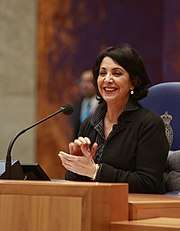
Social and cultural barriers
Mirror representation stems from the barriers female political candidates often face, these include:sex stereotyping,political socialization, lack of preparation for political activity, and balancing work and family. In the media, women are often asked how they would balance the responsibilities of elected office with those to their families, something men are never asked.[49]
Sex stereotyping: Sex stereotyping assumes that masculine and feminine traits are intertwined with leadership. Hence, the bias leveled against women stems from the perception that femininity inherently produces weak leadership.[50] Due to the aggressive and competitive nature of politics, many insist that participation in elected office requires masculine traits.[51] Sex stereotyping is far from being a historical narrative. The pressure is on female candidates (and not male ones) to enhance their masculine traits in order to garner support from voters who identify with socially constructed gender roles. Apart from this, studies by American University in 2011 reveal that women are 60% less likely than men to believe that they are not qualified to take politics responsibility.[52] So, the patriarchy in politics is responsible for less participation of women.
Sexual and Physical Violence: In Kenya, a woman's rights activist named Asha Ali was threatened and beaten by three men for standing as a candidate in front of her kids and elderly mother.[53] A 2010 survey of eight hundred likely U.S voters found that even very mild sexist language had an impact on their likelihood of voting for a woman (Krook, 2017).[53] Even in early 2016, a 14-year-old girl was kidnapped from her bed late at night and raped as revenge for her mother's victory in local elections in India, which is an example of sexual violence.[53] All of this evidence suggests that women face many challenges in a political environment where men try to suppress women whenever they try to raise their voices in politics for making positive change for women's empowerment.
Lack of support of Media: The qualitative and quantitative study reveals that media reflects and strengthens a male-overwhelmed society.[54] Women in the news is usually for bad news and just for all the vulgar or wrong reasons such as about their looks, personal life and their clothes and characters.[54] Media likes to give more updates about all these above examples instead of their actual politics role and achievements[55]
Political socialization: Political socialization is the idea that, during childhood, people are indoctrinated into socially constructed norms of politics. In the case of women's representation in government, it says that sex stereotyping begins at an early age and affects the public's disposition on which genders are fit for public office. Socialization agents can include family, school, higher education, mass media, and religion.[56] Each of these agents plays a pivotal role in either fostering a desire to enter politics, or dissuading one to do so.
Generally, girls tend to see politics as a "male domain".[57] Newman and White suggest that women who run for political office have been "socialized toward an interest in and life in politics" and that "many female politicians report being born into political families with weak gender-role norms."[58]
Women running for U.S senate are often underrepresented in news coverage. The way male and female candidates are depicted in media has an effect on how female candidates gets elected in to public office. Female candidates get treated differently in the media than their male counterparts in the U.S senate elections. Women receive less news coverage and the coverage they do receive concentrates more on their viability and less on their issue positions, which causes female candidates to be overlooked and underrated during elections, which is an obstacle for women running for U.S senate.[59]
Lack of preparation for political activity: An aftereffect of political socialization is that it determines how inclined women are to pursue careers that may be compatible with formal politics. Careers in law, business, education, and government, professions in which women happen to be minorities, are common occupations for those that later decide to enter public office.[58]
Balancing work and family: The work life balance is invariably more difficult for women, because they are generally expected by society to act as the primary caregivers for children and maintainers of the home. Due to these demands, it is assumed that women would choose to delay political aspirations until their children are older. Also, a women's desire for a career in politics along with the extent that the respondent feels her family duties might inhibit her ability to be an elected official.[60] Research has shown that new female politicians in Canada and the U.S. are older than their male counterparts.[61] Conversely, a woman may be pushed to remain childless in order to seek political office.
Institutional barriers may also pose as a hindrance for balancing a political career and family. For instance, in Canada, Members of Parliament do not contribute to Employment Insurance; therefore, they are not entitled to paternity benefits.[62] Such lack of parental leave would undoubtedly be a reason for women to delay seeking electoral office. Furthermore, mobility plays a crucial role in the work-family dynamic. Elected officials are usually required to commute long distances to and from their respective capital cities, which can be a deterrent for women seeking political office.
Pathways to political involvement
Globally, there have been four general pathways that have led women into political office:[63]
- Political family – women in this path come from families that have a long history of involvement in electoral politics.
- Surrogate – women in this path have assumed office, often temporarily, as a surrogate for a father, husband, or brother who has recently died.
- Party or political insider – women in this path start at the bottom of a party or political ladder and work their way up over time filling in necessary roles to show loyalty to the party.
- Political outsider – women in this path usually lack political experience but they run on a platform emphasizing new political changes and serve as an alternative to the status quo.
Policies to increase women's participation
The United Nations has identified six avenues by which female participation in politics and government may be strengthened. These avenues are: equalization of educational opportunities, quotas for female participation in governing bodies, legislative reform to increase focus on issues concerning women and children, financing gender-responsive budgets to equally take into account the needs of men and women, increasing the presence of sex-disaggregated statistics in national research/data, and furthering the presence and agency of grassroots women's empowerment movements.[19]
The first government organization formed with the goal of women's equality was the Zhenotdel, in Soviet Russia in the 1920s.
Education
Women with formal education (at any level) are more likely to delay marriage and subsequent childbirth, be better informed about infant and child nutrition, and ensure childhood immunization. Children of mothers with formal education are better nourished and have higher survival rates.[19] Education is a vital tool for any person in society to better themselves in their career path, and equalization of educational opportunities for boys and girls may take the form of several initiatives:
- abolishment of educational fees which would require parents to consider financial issues when deciding which of their children to educate. Poor children in rural areas are particularly affected by inequality resulting from educational fees.[64]
- encouragement of parents and communities to institute gender-equal educational agendas. Perceived opportunity cost of educating girls may be addressed through a conditional cash transfer program which financially reward families who educate their daughters (thus removing the financial barrier that results from girls substituting school attendance for work in the family labor force).[65]
- creation of "girl-friendly" schools to minimize bias and create a safe school environment for girls and young women. Currently, a barrier to female school attendance is the risk of sexual violence en route to school.[66] A "safe school environment" is one in which the school is located to minimize such violence, in addition to providing girls with educational opportunities (as opposed to using female students to perform janitorial work or other menial labor).[66]
Mark P. Jones, in reference to Norris's Legislative Recruitment, states that: "Unlike other factors that have been identified as influencing the level of women's legislative representation, such as a country's political culture and level of economic development, institutional rules are relatively easy to change".[67]
In an article about the exclusion of Women from politics in southern Africa, Amanda Gouws said "The biggest hurdles to overcome for women are still on the local level where both men and women are often recruited from the communities and have limited political skills".[68] The level of education in these local governments or, for that matter, the people in those positions of power, are substandard.
One example of the hurdles women face in receiving good education comes from Beijing. "Most women who attended the NGO Forums accompanying the UN conferences, which are for government delegations (though increasingly many governments include activists and NGO members among their official delegates), were middle-class educated women from INGOS, donors, academics, and activists".[69] Lydia Kompe, a well-known South African activist, was one of these rural women. She noted that she felt overwhelmed and completely disempowered. In the beginning, she did not think she could finish her term of office because of her lack of education.[68] Manisha Desai explains that: "There is an inequality simply around the fact that the UN system and its locations say a lot about the current focus of those systems, such positions being in the US and Western Europe allow easier access to those women in the area.[69] It is also important to note that institutions affect the cultural propensity to elect women candidates in different ways in different parts of the world."[30]
The study of the history of women's representation has been a major contribution in helping scholars view such concepts. Andrew Reynolds states: "historical experience often leads to gender advancement, and political liberalization enables women to mobilize within the public sphere".[30] He argues that we will see a larger number of women in higher office positions in established democracy than in democracies that are developing, and "the more illiberal a state is, the fewer women will be in positions of power".[30] As countries open education systems to women, and more women participate in historically male dominated fields, it is possible to see a shift in political views regarding women in government.
Quotas

Quotas are explicit requirements on the number of women in political positions.[66] "Gender quotas for the election of legislators have been used since the late 1970s by a few political parties (via the party charter) in a small number of advanced industrial democracies; such examples would be like Germany and Norway".[67] Andrew Reynolds says there is "an increasing practice in legislatures for the state, or the parties themselves, to utilize formal or informal quota mechanisms to promote women as candidates and MPs".[30] The statistics surrounding quota systems have been examined thoroughly by academia. The European Court of Human Rights decided its first female quota case in 2019, and as of December 2019, one male quota case is pending with the court.[70] In Zevnik and Others v Slovenia, the court expressed its strong support for gender quotas as a tool to increase women participation in politics.[71]
Types of quotas include:[66]
- Sex quota systems: institute a "critical value" below which a government is deemed imbalanced. Examples of such critical values include 20% of legislators or 50% of politicians.
- Legal quota systems regulate the governance of political parties and bodies. Such quotas may be mandated by electoral law (as the Argentine quota law, for example) or may be constitutionally required (as in Nepal).
- Voluntary party quota systems may be used by political parties at will, yet are not mandated by electoral law or by a country's constitution. If a country's leading or majority political party engages in a voluntary party quota system, the effect may "trickle down" to minority political parties in the country (as in the case of the African National Congress in South Africa).
Quotas may be utilized during different stages of the political nomination/selection process to address different junctures at which women may be inherently disadvantaged:[66]
- Potential candidacy: sex quota systems can mandate that from the pool of aspirants, a certain percentage of them must be female.
- Nomination: legal or voluntary quotas are enforced upon this stage, during which a certain portion of nominated candidates on the party's ballot must be female.
- Election: "reserved seats" may be filled only by women.
Quota usage can have marked effects on female representation in governance. In 1995, Rwanda ranked 24th in terms of female representation, and jumped to 1st in 2003 after quotas were introduced. Similar effects can be seen in Argentina, Iraq, Burundi, Mozambique, and South Africa, for example.[66] Of the top-ranked 20 countries in terms of female representation in government, 17 of these countries utilize some sort of quota system to ensure female inclusion. Though such inclusion is mainly instituted at the national level, there have been efforts in India to addresses female inclusion at the subnational level, through quotas for parliamentary positions.[72]
With quotas drastically changing the number of female representatives in political power, a bigger picture unravels. Though countries are entitled to regulate their own laws, the quota system helps explain social and cultural institutions and their understandings and overall view of women in general. "At first glance, these shifts seem to coincide with the adoption of candidate gender quotas around the globe as quotas have appeared in countries in all major world regions with a broad range of institutional, social, economic and cultural characteristics".[73]
Quotas have been quite useful in allowing women to gain support and opportunities when attempting to achieve seats of power, but many see this as a wrongdoing. Drude Dahlerup and Lenita Freidenvall argue this in their article "Quotas as a 'Fast Track' to Equal Representation for Women" by stating: "From a liberal perspective, quotas as a specific group right conflict with the principle of equal opportunity for all. Explicitly favoring certain groups of citizens, i.e. women, means that not all citizens (men) are given an equal chance to attain a political career".[74] Dahlerup and Freidenvall claim that even though quotas create theoretical imbalance in opportunity for men and that they necessarily break the concept of "classical liberal notion of equality",[74] quotas are almost required to bring the relation of women in politics to a higher state, whether that is through equal opportunity or just equal results.[74] "According to this understanding of women's under-representation, mandated quotas for the recruitment and election of female candidates, possibly also including time-limit provisions, are needed".[74]
The introduction of gender quotas in the electoral process has spurred controversy from politicians, resulting in resistance to the acceptance of quotas in the political realm.[75] The mobilization of women in politics has been hindered by means of preserving male political survival, and to avoid political interference with male power and domination.[75] Moreover, the implementation of gender quotas has caused the male candidate population to decrease in order for their female counterparts to participate, and this is commonly referred to as the "negative sum," and this can result in a more qualified male being rejected to allow a female politician to participate.[75] Furthermore, in the case of Argentina, which is currently mandated for a 30% female party at each level of government, saw the introduction of the 'quota women'; females that were less experienced, and only elected due to the legal requirement of quotas.[76] The introduction of the 'quota women' has triggered what political scientists refer to as a 'mandate effect,' where quota women feel obligated to represent solely the interests of the female public.[76] Moreover, in order to preserve male political survival, "domination techniques" have been utilized to both exclude and delegitimize female representation in politics, and this can be depicted in the case of Argentina, where it took several elections to gain 35% of female representatives.[76] With the increase of female representation in Argentina, issues that were rarely discussed before became paramount in debates, such as "penal laws, sexual assault laws, and laws on maternity leave and pregnancy... sexual education, [and] emergency contraceptive."
Substantive representation contains two distinct parts: both the process and outcome of having female politicians.[76] Substantive representation based on the process is concerned with the gendered perspective, themes that female representatives discuss in political debates, and the impact they have on the creation of bills.[76] Likewise, this process also includes the networking between women in government and female organizations.[76] Substantive representation by outcome relates to the success of passing legislation that enables gender equality to both public and private issues.[76] Moreover, substantive representation as process does not always result in substantive representation by outcome; the implementation of gender quotas and female representation does not directly instigate an influx in legislation.[76]
Critical mass theory has correlations with both substantive representation as process and substantive representation as outcome. Critical mass theory suggests that once a certain percentage of women representatives has been reached, that female legislators will be able to create and enable transformative policies, and this has the potential to place pressure on quota women to act on behalf of all women.[76] One paramount criticism of critical mass theory is its attention to numbers, and the understanding that quota women are to represent women collectively.[76] Furthermore, the representation of women as a collective group remains controversial, as "[if] she is a white straight, middle-class mother, she cannot speak for African-American women, or poor women, or lesbian women on the basis of her own experience anymore than men can speak for women merely on the basis of theirs."[76]
A 2018 study in The Journal of Politics found that the implementation of electoral gender quotas which substantially increased women's representation in parliament led to increased government expenditures toward public health and relative decreases in military spending.[77]
Legislation
There have been numerous occasions where equal legislation has benefited the overall progression of women equality on a global scale. Though women have entered legislation, the overall representation within higher ranks of government is not being established. "Looking at ministerial positions broken down by portfolio allocation, one sees a worldwide tendency to place women in the softer sociocultural ministerial positions rather than in the harder and politically more prestigious positions of economic planning, national security, and foreign affairs, which are often seen as stepping-stones to national leader ship".[30]
Legislative agendas, some pushed by female political figures, may focus on several key issues to address ongoing gender disparities:
- Reducing domestic and gender-based violence. The Convention on the Rights of the Child, published by the United Nations in 1989, addressed home violence and its effects on children. The Convention stipulates that children are holders of human rights, and authorizes the State to 1) prevent all forms of violence, and 2) respond to past violence effectively.[78] Gender-based violence, such as the use of rape as a tool of warfare, was addressed in Resolution 1325 of the UN Security Council in 2000. It calls for "all parties of armed conflict to take special measures to protect women and girls from gender-based violence."[79]
- Reducing in-home discrimination through equalizing property and inheritance rights. National legislation can supersede traditionally male-dominated inheritance models. Such legislation has been proven effective in countries like Colombia, where 60% of land is held in joint titles between men and women (compared to 18% before the passage of joint titling legislation in 1996).[80]
Financing
Sex-responsive budgets address the needs and interests of different individuals and social groups, maintaining awareness of sexual equality issues within the formation of policies and budgets. Such budgets are not necessarily a 50–50 male-female split, but accurately reflect the needs of each sex (such as increased allocation for women's reproductive health.[81] Benefits of gender-responsive budgets include:
- Improved budget efficiency by ensuring that funds are allocated where they are needed most
- Strengthened government position by advocating for needs of all, including the poor and the underrepresented rights
- Increased information flow surrounding needs of those who are usually discriminated against
A sex-responsive budget may also work to address issues of unpaid care work and caring labor gaps.[81]
Research/data improvements
Current research which uses sex-aggregated statistics may underplay or minimize the quantitative presentation of issues such as maternal mortality, violence against women, and girls' school attendance.[19] Sex-disaggregated statistics are lacking in the assessment of maternal mortality rates, for example. Prior to UNICEF and UNIFEM efforts to gather more accurate and comprehensive data, 62 countries had no recent national data available regarding maternal mortality rates.[82] Only 38 countries have sex-disaggregated statistics available to report frequency of violence against women.[82] 41 countries collect sex-disaggregated data on school attendance, while 52 countries assess sex-disaggregated wage statistics.[82]
Though the representation has become a much larger picture, it is important to notice the inclination of political activity emphasizing women over the years in different countries. "Although women's representation in Latin America, Africa, and the West progressed slowly until 1995, in the most recent decade, these regions show substantial growth, doubling their previous percentage".[16]
Researching politics on a global scale does not just reinvent ideas of politics, especially towards women, but brings about numerous concepts. Sheri Kunovich and Pamela Paxton research method, for example, took a different path by studying "cross-national" implications to politics, taking numerous countries into consideration. This approach helps identify research beforehand that could be helpful in figuring out commodities within countries and bringing about those important factors when considering the overall representation of women. "At the same time, we include information about the inclusion of women in the political parties of each country".[17] Research within gender and politics has taken a major step towards a better understanding of what needs to be better studied. Mona Lena Krook states: These kinds of studies help establish that generalizing countries together is far too limiting to the overall case that we see across countries and that we can take the information we gain from these studies that look at countries separately and pose new theories as to why countries have the concepts they do; this helps open new reasons and thus confirms that studies need to be performed over a much larger group of factors.[83] Authors and researchers such as Mala Htun and Laurel Weldon also state that single comparisons of established and developed countries is simply not enough but is also surprisingly hurtful to the progress of this research, they argue that focusing on a specific country "tends to duplicate rather than interrogate" the overall accusations and concepts we understand when comparing political fields.[84] They continue by explaining that comparative politics has not established sex equality as a major topic of discussion among countries.[84] This research challenges the current standings as to what needs to be the major focus in order to understand gender in politics.
A 2018 study in the American Economic Journal: Economic Policy found that for German local elections "female council candidates advance more from their initial list rank when the mayor is female. This effect spreads to neighboring municipalities and leads to a rising share of female council members."[85]
Grassroots empowerment movements
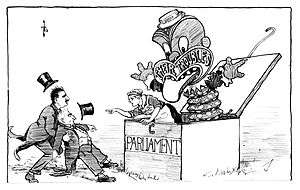
Women's informal collectives are crucial to improving the standard of living for women worldwide. Collectives can address such issues as nutrition, education, shelter, food distribution, and generally improved standard of living.[86] Empowering such collectives can increase their reach to the women most in need of support and empowerment. Though women's movements have a very successful outcome with the emphasis on gaining equality towards women, other movements are taking different approaches to the issue. Women in certain countries, instead of approaching the demands as representation of women as "a particular interest group", have approached the issue on the basis of the "universality of sex differences and the relation to the nation".[84] Htun and Weldon also bring up the point of democracy and its effects on the level of equality it brings. In their article, they explain that a democratic country is more likely to listen to "autonomous organizing" within the government. Women's movements would benefit from this the most or has had great influence and impact because of democracy, though it can become a very complex system.[84] When it comes to local government issues, political standings for women are not necessarily looked upon as a major issue. "Even civil society organizations left women's issues off the agenda. At this level, traditional leaders also have a vested interest that generally opposes women's interests".[68] Theorists believe that having a setback in government policies would be seen as catastrophic to the overall progress of women in government. Amanda Gouws says that "The instability of democratic or nominally democratic regimes makes women's political gains very vulnerable because these gains can be easily rolled back when regimes change. The failure to make the private sphere part of political contestation diminishes the power of formal democratic rights and limits solutions to gender inequality".[68]
Case studies
Afghanistan
After the Taliban were toppled down in 2001 by the United States of America invasion of Afghanistan, the Afghan Women's Political Participation has significantly improved. Today, Afghan women work in various layers of decision making positions in the Government of Afghanistan. The proportion of seats held by women in the Parliament of Afghanistan has increased from 4 percent in 1995 to 28 percent in 2018.[87] There are 4 women Cabinet Ministers,[88] and there are many Afghan women who are appointed as Afghan Ambassadors, such as Roya Rahmani,[89] Suraya Dalil,[90] and Shukria Barekzai.[91] On the other hand, there are hundreds of women working running private companies, non-profit organizations, and civil society organizations in Afghanistan. There were several women running as vice-presidential candidates in the Presidential Elections of Afghanistan in 2014.[92][93]
Australia
In 1902, Australia became the first country to give some women the vote and allow them to stand for Parliament. This did not apply to Aboriginal Australians, including women, until the amendment of the Electoral Act in 1962. It wasn't until 1983 that Indigenous people had voting rights entirely equal to white Australians when another amendment made enrollment to vote compulsory, rather than voluntary.[94] 19 years after the Commonwealth Franchise Act was passed, Edith Cowan was elected to Legislative Assembly and became the first woman ever elected in any Australian Parliament. Dorothy Tangney was the first woman elected to the Australian senate in 1946, a seat she held for twenty-five years. In the same year, Dame Enid Lyons became the first woman elected to the House of Representatives. In 1986, Joan Child becomes the first female elected to Speaker of the House of Representatives and held the position for over three years.[95] Of the two major political parties in Australia, the Australian Labor Party (ALP) introduced a 35% quota in 1994 and increased this to 40% in 2002 whereas the Liberal National Party (LNP) currently has no gender-based quotas.[96][97]
As of May 2018, women comprise approximately 38% of senators and occupy 44 of the 150 seats in the House of Representatives. In the current 45th Parliament, the ALP exceeds their 40% quota and is made up of 44% women and the LNP 21%.[94] At January 1, 2017, Australia was ranked 52 out of 175 countries in terms of women in ministerial positions and 50th out of 190 countries in terms of women in the lower house of Parliament. The report issued by UN Women found 24.1% of, or 7 out of the 29 Australian ministers were women.[98]
2007 was a notable year for women in Australian Parliament. Anna Bligh became Queensland's first female premier, a position she occupies for five years, and Julia Gillard MP becomes Deputy Prime Minister. Three years later, Gillard is elected as Australia's first female prime minister. Dame Quentin Bryce became the first and only woman appointed to Governor-General, a position that is representative of the Monarch, in 2008 and served until 2014. Christine Milne is the only woman that has been head of a major political party when she was elected leader of the Australian Greens in 2012.[94]
Indigenous people, women in particular, are grossly underrepresented in Australian Parliament. Since Federation in 1901, there have been 40 Indigenous Australians involved in any Parliament (sixteen women) and eight in the Federal Parliament (four women). Following are some notable figures:[95]
- Carol Martin of Western Australia was the first Indigenous woman elected to any Australian Parliament in 2001 and was subsequently re-elected in 2005 and 2008.
- Marion Scrygmour of the Northern Territory became the first Aboriginal woman minister in any Australian government in 2002 and became the highest-ranked Indigenous woman in government with her service as Chief Minister of the Northern Territory from 2007–2009.
- Linda Burney, New South Wales, becomes the first Aboriginal person elected to a State Parliament in 2003 and the first Aboriginal woman elected to the House of Representatives in 2016.
- Joanna Lindgren occupied a Senate seat for little over a year from 2015.
- Malarndirri McCarthy was elected to the Northern Territory's government in 2005 and gained a Senate seat in 2016.
- The first Aboriginal woman to be elected to Federal Parliament was Nova Peris in 2013 after being selected as a Northern Territory Senate candidate.[99]
Azerbaijan
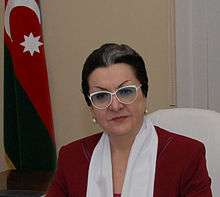
In Azerbaijan, placing women in government has progressed better than in other Islamic countries. Universal suffrage was introduced in Azerbaijan in 1918 by the Azerbaijan Democratic Republic, thus making Azerbaijan the first Muslim-majority countries and Turk-majority countries ever to enfranchise women. Now, 28 women are members in the Azerbaijan Parliament (Milli Məclis). As of 2015, there were 21 women in the 125-seat parliament. The percentage of female members of parliament increased from 11 to 17 percent between 2005 and 2015. Traditional social norms and lagging economic development in the country's rural regions continued to restrict the role of women in the economy, and there were reports that women had difficulty exercising their legal rights due to gender discrimination. As of May 2009, women held the positions of Deputy Chairman of the Constitutional Court, Deputy Chairman of the Nakhchivan AR Cabinet of Ministers, four Deputy Ministers, an Ambassador, and Ombudsmen of Azerbaijan and Nakhchivan AR. Women constituted 4 of the 16 members of the Central Election Commission and chaired 3 of the 125 district election commissions. Some famous female managers in historical Azerbaijan territories mentioned below:
- Tomyris – antic women leader of Scythians, was born in near of Araks River
- Amytis of Media – the daughter Median king Cyaxares, and the wife of Nebuchadnezzar II.
- Sparama – most important person of Caucasian Albania (for 9th century)
- Abish Khatun – governor of Fars from 1283 to 1287 (Salghurids or Atabegs of Turk)
- Sara Khatun – a first female politicians in Islamic World, shahbanu of Ak Koyunlu Empire.
- Tajlu Khanum – was a Turcoman princess, politicians and warrior of Safavid Empire
- Raziya Khatun – Shah (Emperor) of Safavid Empire (during 1736–1749)
- Elena Stasova – World's first communist female president (chairman) during 1 week
- Zuleykha Seyidmammadova – was a Minister of Social Security and first female Azerbaijani military pilot.
- Ayna Sultanova – the first Azerbaijani female cabinet minister (People's Commissar of Justice).
- Sima Eyvazova – was first non-Russian diplomat of USSR, Minister of Foreign Affairs of Azerbaijan, members of United Nations.
- Sakina Aliyeva – the first Azerbaijani female head of parliament.
- Tahira Tahirova – Minister of Foreign Affairs of Azerbaijan.
- Elmira Gafarova – was a Speaker of the National Assembly of Azerbaijan, and Minister of Foreign Affairs of Azerbaijan
- Lydia Rasulova – was a Minister of Social Security (1988–1992), Minister of Education (1993–1997).
- Leyla Yunus – Chairman of Information and Analysis Center of Ministry of Defence.
- Lala Shevket – is an Azerbaijan politician, world's first female Secretary of State between 1993 and 1994.
- Sudaba Hasanova – was a Minister of Justice
- Mehriban Aliyeva – Vice President, the head of Heydar Aliyev Foundation.
- Maleyka Abbaszadeh – the chair of the State Students Admission Commission.
- Hijran Huseynova – is chairwomen of the State Committee for Family, Women and Children Affairs.
- Elmira Süleymanova – is first Ombudsman
- Ganira Pashayeva – is a Member of the National Assembly of Azerbaijan.
- Havva Mammadova – Diplomat, Member of National Assembly of Azerbaijan.
- Leyla Aliyeva – Director of International Dialogue for Environmental Action.
- Govhar Bakhshaliyeva – is the director of the Institute of Oriental Studies of the Russian Academy of Sciences.
Brazil
Bertha Lutz was the founding mother of the Brazilian woman suffrage movement. In 1919 she founded the League for Intellectual Emancipation of Women. Lutz also created the Brazilian Federation for Women's Progress (1922), a political group which advocated for Brazilian women's rights, most importantly, their right to vote. She later played a central role as a member of the small group of feminists at the 1945 founding of the United Nations.[100]
A 1995 Brazilian gender quota was extended first to city councilor positions in 1996, then extended to candidates of all political legislative positions by 1998.[101] By 1998, 30% of political candidates had to be women, with varied results in terms of the gender balance of the officials ultimately elected. Though the percentage of national legislature seats occupied by women dropped in the initial years following the passage of the quota law, the percentage has since risen (from 6.2% pre-quota, to 5.7% in 1998, to 8.9% in 2006). However, Brazil has struggled with the quota law in several respects:
- Though the quota law mandates a certain percentage of candidate spots be reserved for women, it is not compulsory that those spots be filled by women.
- The quota law also allowed political parties to increase the number of candidates, further increasing electoral competition and having a negligible impact on the actual number of women elected.
In Brazil, the Secretariat of Policies for Women, was until recently the main Brazilian state-feminism agency at the federal level. Under Workers' Party governments (2003-2016), Brazil carried out women-focused policies in three dimensions of its foreign policy: diplomacy, development cooperation, and security.[102]
China
China's stipulation for gender equality in the political sphere started on as early as recorded in its 1954 Constitution, in which the PRC government stated that men and women enjoy equal rights in the aspects of political, economic, cultural, social and family dimensions, especially highlighting legitimate voting right and the right to be elected.[103] Another State document – Law of the People's Republic of China on the Protection of Rights and Interests of Woman – also outlined an official requirement of 'appropriate number of women deputies', combined with the State's obligations to 'gradually increase the proportion of the women deputies' and 'actively trains and selects female cadres' in fundamental national institutions and political organizations.[104] For decades that follow, China has been making revision to its constitutional laws and State announcements to give recognition to women's role in the domain of governance. An example of which is the proclamation issued on the 5th meeting session of the 10th National People's Congress (NPC) necessitating that 'the proportion of women delegates to be elected to the 11th People's Congress should be no less than 20%'.
.jpg)
However, regardless of the proper representation of women's political eligibility across multiple government declarations, the political system in China remains overwhelmingly male-dominated which in turns drives the low engagement rate of women delegates. Despite the new 13th NPC lineup with a composition of 742 women out of 2,980 representatives, which amounts to 24.9% penetration with 1.5 points increase as opposed to the former term,[105] there is mere presence of women in the central power structure in major government organs and their political influences are vastly diminished as they climb up the political ladder. Justifications of the above statement include the fact that only 33 women (9%) are recorded to have a seat at the table of Central Committee for the election of members into the Politburo, a key cornerstone for the approval all national affairs.[106] In fact, except for the two consecutive office in 1973 and 1977, the Central Committee has never witnessed over 10% of women engagement in the organization.[107] Associated with the above figure is the decline in the 25-member Politburo from two women down to one. In addition, the recent reappointment of Xi Jinping, General Secretary of the Chinese Communist Party, has sparked controversy on the unbroken record of no-women Politburo Standing Committee and absence of female top leaders in any legislature in China's political history, apart from the exceptions of Vice Premier, Liu Yandong and Vice Foreign Minister, Fu Ying. The public has been compelled to draw parallel with Hong Kong and Taiwan where female presidents – Carrie Lam and Tsai Ing-wen – took office in 2018 and 2016 respectively.[108]
The male-heavy politics amidst the favorable women's right protection in China can be examined from the following underlying causes:
(1) Deprivation of upward mobility
While the implied prerequisite of national appointment is years of experience serving at middle-to-top management, women in the PRC government often struggle to obtain promotion to high-ranked positions, such as party secretary or principal governor.[106] The reason contributing to the captioned phenomenon is gender division of labor across all levels of political structures. Contrary to Mao Zedong's saying that 'Women hold up half of the sky', Confucians principles' deeply ingrained advocacy "nan zhu wai, nu zhu nei" (men working on the outside, women's place remains on the inside) has shaped gender division of labor.[109] Being assigned highly gender-biased responsibilities within the spectrum of 'women affairs', such as family planning that are reproduction-oriented or with connection to social construction, women's public role and scope of duty are framed under constraints. Women are, at the same time, missing the opportunities to keep a foothold in strategic national affairs, including but not limited to economic development, military planning and diplomatic involvement. The mentioned dilemma is reflected by an actual example in Ning Xiang County, Hunan Province. Women commonly maintain highest authority as Head in women-related bodies, administering concerns on women's unfair treatments and suggesting for children's health development.[110] By the same token, the gendered portfolio gives rise to empowerment of male in the political hierarchal. Consequently, with the lack of exposure to the exemplary official posts and the exclusive offering of key national assignments for men, women's upward mobility is aggravated, resulting in the substantially dwindling likelihood of taking residence in key leading positions.
(2) Biased retirement precondition prejudicing against women
In China, there is an apparent discrepancy in the mandatory retirement age between men and women, in which men are entitled to enjoy 10 more years of work. This policy was established on the ground that women are primary and central support for domestic subjects and their early retirement (at the age of 50–55) would be beneficial to their overall family functioning.[108] This discriminatory policy mirrors the cause in the previous part, in which the working capacity of women is restricted by the society's stereotype on their gender role and corresponding gender responsibilities. In addition, the average age of Chinese chief in Central Committee is 56.1 years old; Top leaders in Politburo were appointed at an average age of 61.1 years old; Whereas Standing Committee of Politburo has the highest average age of 63.4 for its office.[111] All figures being examined, the aggregated average age of appointed leaders exceeds the legal retirement age of women in the nation, meaning that women are least likely to become the center of power before their career come to an end.
(3) Anti-feminism
While in foreign countries, women's socio-economic status is uplifted and gender division of labor is largely wiped out by feminist movements to open up the availability and variety of work for women, the conservative and politically-sensitive Chinese government's censorship on feminism within the country has spread fear among feminism advocates. An illustrative case of which is the backlash of 'Feminist Five' in China. The activists suffered from interrogation, detention and month-long imprisonment due to the distribution of stickers on Beijing subways for drawing the wider community's awareness to sexual harassment against women.[112] Followed by the forced suspension of Weibo account 'Feminist Voices' due to the government's tightened censorship, feminist encountered escalated obstacles in promoting gender equality. Feminist movements are yet to achieve their goals.
Germany
The gender quotas implemented across parties in Germany in the 1990s serve as a natural experiment for the effect of sub-national party political gender quotas on women participation. Davidson-Schmich (2006) notes, "the German case provides the variance needed to explain the successful (or failed) implementation of these political party quotas".[113] Germany's sixteen state legislatures, the Länder, feature a variety of party systems and varied numbers of potential female candidates. Germany is rated highly in its gender gap, but is an example of a developed country with a low percentage of female leadership in politics. Davidson-Schmich's study shows that there are many factors that influence how effective a political quota for women will be. Because Germany's quotas cover culturally diverse areas, Davidson-Schmich was able to see which cities best responded to the increase in women running for office. In her bivariate study, the quota was more successful when the city had a PR electoral system, when more women held inner-party and local political offices, and when there were more women in state-level executive offices. The quota was less successful in rural areas, areas with a large number of Catholic voters, electoral systems with a preferential system, in extremely competitive party systems, and with greater rates of legislative turnover. In her multivariate study of these regions, however, Davidson-Schmich narrowed these factors down even further to the most significant variables of: Catholicism and agricultural economics (Davidson-Schmich, 2006, p. 228). This is very intriguing, and as she explains, "the success of voluntary gender quotas in the German states hinged not on the political structure of these Lander, but rather the willingness of within the system to act on the opportunities inherent in these structures" (Davidson-Schmich, 2006, p. 228). Social factors and inherent gender discrimination are more important in the success of a female political quota than the structure of the quota itself.
India

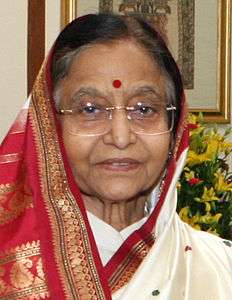
In an effort to increase women's participation in politics in India, a 1993 constitutional amendment mandated that a randomly selected third of leadership positions at every level of local government be reserved for women.[114] These political reservation quotas randomly choose one third of cities to implement a women-only election.[115] In these cities, parties are forced to either give a ticket to a women candidate or choose to not run in those locations. Due to the randomized selection of cities who must enforce the reservation for women each election year, some cities have implemented the quota multiple times, once or never. This addresses the political discrimination of women at various levels: parties are forced to give women the opportunity to run, the women candidates are not disadvantaged by a male incumbent or general biases for male over female leadership, and the pool of women candidates is increased because of the guaranteed opportunity for female participation.[115] The effects of the quota system in India have been studied by various researchers. In Mumbai, it was found that the probability of a women winning office conditional on the constituency being reserved for women in the previous election is approximately five times the probability of a women winning office if the constituency had not been reserved for women".[115] Furthermore, that even when the mandates are withdrawn, women were still able to keep their positions of leadership. Given the opportunity to get a party ticket, create a platform and obtain the experience to run for a political position, women are much more likely to be able to overcome these hurdles in the future, even without the quota system in place.[115] The quota system has also affected policy choices. Research in West Bengal and Rajasthan has indicated that reservation affected policy choices in ways that seem to better reflect women's preferences.[116] In terms of voter's perception of female leaders, reservation did not improve the implicit or explicit distaste for female leaders—in fact, the relative explicit preference for male leaders was actually strengthened in villages that had experienced a quota. However, while reservation did not make male villagers more sympathetic to the idea of female leaders, it caused them to recognize that women could lead. Moreover, the reservation policy significantly improved women's prospects in elections open to both sexes, but only after two rounds of reservation within the same village.[117] Political reservation for women has also impacted the aspirations and educational attainment for teenage girls in India.[118]
Indira Gandhi is the first female prime minister of India. She is the daughter of Jawaharlal Nehru, the first prime minister of India. She served as Prime Minister from January 1966 to March 1977 and again from January 1980 until her assassination in October 1984, making her the second longest-serving Indian Prime Minister, after her father. Pratibha Patil is the first female president of India. She served as the 12th President of India from 2007 to 2012. Sixteen women have served as the chief minister of an Indian state. Currently, one is in office — Mamata Banerjee of West Bengal.
Following the 2019 elections, the 17th Lok Sabha has the highest ever representation of women at 14.3%, which includes 78 women MPs out of 543, higher than 62 in 2014. But only 6 women became cabinet ministers, lower than 10 in 2014.
Indian panchayats (local government)
The local panchayat system in India provides an example of women's representation at the local governmental level.[26] The 73rd and 74th Constitutional Amendments in 1992 mandated panchayat elections throughout the country. The reforms reserved 33% of the seats for women and for castes and tribes proportional to their population. Over 700,000 women were elected after the reforms were implemented in April 1993.Pathways to political involvement
Ireland
In 1990, Mary Robinson was elected as the first female President of Ireland. The second female president, Mary McAleese, was president between 1997 and 2011. Ninety-two women have been elected to Dáil Éireann, the first being Constance Markievicz in 1919. Directly prior to this, in 1918, she became the first woman elected to the House of Commons of the United Kingdom, although in line with Sinn Féin abstentionist policy she did not take her seat.
Following the 2011 Irish general election and a re-shuffle in 2014, four women were appointed cabinet ministers (the highest number of women in senior ministerial positions ever in Ireland): Joan Burton, Frances Fitzgerald, Jan O'Sullivan and Heather Humphries.[119]
Women remain a small minority of political office-holders in Ireland. The main factors are the role of traditional Catholicism in Irish political culture and the role of localism in party politics.[120] Ann Marie O'Brien has studied the women in the Irish Department of External Affairs associated with the League of Nations and United Nations, 1923–1976. She finds that women had greater opportunities at the UN.[121]
Israel
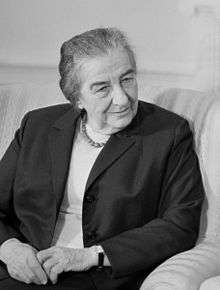
Since the founding of the State of Israel, relatively few women have served in the Israeli government, and fewer still have served in the leading ministerial offices. While Israel is one of a small number of countries where a woman—Golda Meir—has served as Prime Minister, it is behind most Western countries in the representation of women in both the parliament and government.
As of 2019, women comprise 25% of Israel's 120-member Knesset.[122]
Japan
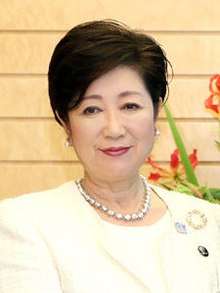
Japan ranks 127 in the world for the number of women in national parliamentary worldwide as of March 2014, which is lower than that of 2013 in which Japan ranked at 122.[123] As of February 28, 2013, there are a total of 39 women in the House of Representatives out of 479 incumbents.[124] Since the enactment of the modern Japanese Constitution in 1947, Japanese women have been given the right to vote, and the new version of the constitution also allows for a more democratic form of government that guarantees women equality under the law. The first female cabinet member, Masa Nakayama, was appointed as the Minister of Health and Welfare in Japan in 1960.[125] Until 1996, the electoral system for the House of Representatives was based on a single non-transferable vote in multi-member districts. That system was not conducive to women's advancement in public office because it promoted contestation between competing parties and rival candidates within the same party, but overall, the new electoral system was introduced to reduce the excessive role of money and corruption in elections, which ultimately helped women who were running for public office.[126] In Japanese politics, the kōenkai is a major factor for a successful outcome of an election. The kōenkai, or "local support groups", serve as pipelines through which funds and other support are conveyed to legislators and through which the legislators can distribute favors to constituents in return. Because gaining support from these groups is usually based on personal connections, women's historically disadvantaged position in networking circles hurts their ability to run for public office.[127]
By 1996, Japan adopted another new electoral system for the House of Representatives that combines single-seat districts with proportional representation. Out of 480 seats, 300 are contested in single seat constituencies. The other 180 members are elected through allocations to an electoral list submitted by each party. Candidates who lack a strong support system are listed on a party's proportional representation section. In the 2009 election, only two of eight female Liberal Democratic Party members were elected from a single-seat district, which indicates that few female candidates have enough political support to win a single-seat election.[128] While changes in the electoral process have made positions of public office more accessible to women, the actual participation of women in the Diet remains relatively low. As for the future of women in politics in Japan, Prime Minister Shinzō Abe announced in his speech at the Japan National Press Club on April 19, 2013, that a major goal of his national growth strategy is "having no less than 30 per cent of leadership positions in all areas of society filled by women by 2020."[129]
Lebanon

Lebanese women are considered to have more rights and freedom compared to other women in the Gulf and Middle East. Lebanese women enjoy almost equal civil rights as men. However, due to the large number of officially recognized religions in Lebanon, Lebanese family matters are governed by at least 15 personal statute codes. Lebanese women have legal protection that varies depending on their religion.
Local and regional NGOs have helped to increase awareness of violence against women in Lebanon.[130][131] Government policies regarding this are poor however, and attempts to improve this area have been met with resistance.[132] Lebanon's laws do not recognize the concept of spousal rape,[133] and attempts to add this to law have been attacked by Lebanese clerics.[134]
Myanmar
.jpg)
Aung Sang Suu Kyi is a Burmese politician, diplomat, author, and Nobel Peace Prize laureate (1991). She is the de facto head of the government of Myanmar since 2016. She remained under house arrest for almost 15 years from 1989 to 2010, becoming one of the world's most prominent political prisoners.
Although she was prohibited from becoming the President due to a clause in the constitution – her late husband and children are foreign citizens – she assumed the newly created role of State Counsellor, a role akin to a Prime Minister or a head of government. Incumbent president Win Myint is seen as an important ally and placeholder for Aung San Suu Kyi.
Netherlands
In 2016, the Dutch government achieved their goal for women in top jobs within the government. A 30% female share was achieved two years earlier than anticipated.[135]
In business, the number of women in top jobs is behind in the political sector. In 2013, the listed companies inserted a 'one in three' rule, which meant that of every three top jobs, one must be exerted by a woman. Not long after, it turned out companies did not put much effort in to achieving this goal, as in practice even less than one in every ten top jobs was occupied by women. The goal for women in top jobs was postponed to 2023. Government and the business sector agreed that if every one in five top jobs is not exerted by women, after 2018 the 30% rule will become mandatory.[136]
Meanwhile, women's quota received a fair share of criticism. It has been argued that women should be employed based on their own qualities, not because of their gender.[136]
New Zealand
In 1893, New Zealand became the first self-governing country in the world to allow women to vote.[137] This included both European and Māori women. Elizabeth Yates became the first female mayor in the British Empire in 1893.[138] However, it was not until 1919 that women were allowed to run for Parliament, and Elizabeth McCombs became the first women elected to the Parliament in 1933.[139]
In the early twentieth-century party leaders--all of them men--were reluctant to allow women rights beyond basic suffrage, but wartime speeded up change. By 1972, the Second Wave of Feminism and the changing attitudes of some party leaders resulted in women gaining more opportunities to become MPs and by 2001 an unprecedented number of women held leadership positions in the New Zealand Parliament.[140]
In recent times New Zealand has had many women in top leadership and government roles including the current Prime Minister Jacinda Adern. New Zealand has a gender pay gap of 9.3%.
Nordic countries
The Nordic countries have been forerunners in including women in the executive branch. The second cabinet Brundtland (1986–1989) was historical in that 8 out of 18 cabinet members were women, and in 2007 the second cabinet Stoltenberg (2005–2013) was more than 50% women. In 2003, Finland had a historical moment when all top leaders of the country were women and also represented different political parties: Social democrat Tarja Halonen was President, Riitta Uosukainen from National Coalition Party was Speaker of the Parliament and after the parliamentary elections of 2003 Anneli Jäätteenmäki from Center party was on her way to become the first female Prime Minister of Finland. Between 2007 and 2011 the Finnish cabinet was 60% female, with a female Prime Minister from 2010 to 2011. Between 2014 and 2015 the Finnish cabinet was 59% female. On June 22, 2010 Mari Kiviniemi of the Centre Party was appointed the second female Prime Minister of Finland. The present Danish government is a coalition between the Social Democrats, the Social-Liberal Party and the Socialist People's Party. All three parties have female leaders. Helle Thorning-Schmidt is Prime Minister.[141]
Finland
The Finnish national quota law, introduced in 1995, mandates that among all indirectly elected public bodies (at both a national and a local level), neither sex in the governing body can be under 40%.[142] The 1995 laws was a reformed version of a similar 1986 law. Unlike other countries' quota laws, which affect party structure or electoral candidate lists, the Finnish law addresses indirectly elected bodies (nominated by official authorities)—the law does not address popularly elected bodies. The Finnish law heavily emphasizes local municipal boards and other subnational institutions. From 1993 (pre-quota law) to 1997 (post-quota law), the proportion of women on municipal executive boards increased from 25% to 45%. The quota law also affected gender segregation in local governance: before the passage of the law, there had been a gender imbalance in terms of female overrepresentation in "soft-sector" boards (those concerned with health, education, etc.) and female "underrepresentation" in "hard-sector" boards (those concerned with economics and technology). In 1997, the boards were balanced horizontally. However, areas not subject to quota laws continue to be imbalanced. In 2003, it was determined that only 16% of the chairs of municipal executive boards are female—chair positions in this area are not quota-regulated.[143] Presidential elections were held in Finland on 16 January 2000, with a second round on 6 February;[144] the result was a victory for Tarja Halonen of the Social Democratic Party, who became the country's first female President.
Romania
No political gender quotas exist in Romania, however the Equality Act of 2002 provides that public authorities and institutions, political parties, employers' organizations and trade unions must provide an equitable and balanced representation of men and women at all decisional levels.[145] Following the 2016 elections, women gained only 20.7% of seats in the Lower House (Romanian Chamber of Deputies) and 14.7% in the Upper House (Senate of Romania).[72] These figures are up from the 4.9% of women in the Romanian Parliament in 1990.[146] On the other hand, women are well represented in the central public administration, including the Government, with more than half of decision-making positions held by women, according to a 2011 study commissioned by the Ministry of Labor.[147] Viorica Dăncilă is the Prime Minister of Romania since 29 January 2018.[148] She is the first woman in Romanian history to hold the office of Prime Minister.
Rwanda
Since the election of 2008, Rwanda is the first country to have a majority of women in legislature.[149][150] Rwanda is an example of a developing country that does not have spectacular gender equality in other aspects of society, but radically increased its female leadership because of national conflict. After the genocide that killed 800,000 Tutsis in 100 days, women in legislature went from 18% women before the conflict to 56% in 2008. Two pieces of legislature enabled and supported women into leadership positions: the Security Council Resolution of 1325 urged women to take part in the post-conflict reconstruction and the 2003 Rwandan Constitution included a mandated quota of 30% reserved seats for all women in legislature. Of the 24 women who gained seats directly after the quota implementation in 2003, many joined political parties and chose to run again. Though it took almost 10 years, after implementing the gender quotas, Rwanda reached levels of female representation which are amongst the highest in the world.[2] Once again we can see the quota working as an "incubator" for driving women's participation in leadership.
It is argued that the increase of female leadership in Rwanda also led to an increase in gender equality. World Focus (2009) writes, "Rwandan voters have elected women in numbers well beyond the mandates dictated by the post-genocide constitution.[151] And though women in Rwanda still face discrimination, female legislators have influenced major reforms in banking and property laws." A parliamentary women's caucus in Rwanda, the Rwanda Women Parliamentary Forum (FFRP) has also "led a successful effort to pass ground-breaking legislation on gender-based violence in part by involving and garnering support from their male colleagues".[150]
While some researchers see reform, others see dominant party tactics. Shireen Hassim (2009) writes, "It could be argued that in both countries [Uganda and Rwanda] women's representation provided a kind of alibi for the progressive, 'democratic' nature of new governments that at their core nevertheless remained authoritarian, and increasingly so".[152] Rwanda shows that increased participation by women in democracy is conducive to progress in gender equal legislature and reform, but research must be careful not to immediately relate increased gender equality in politics to increased gender equality in policy.
Spain
In 2007, Spain passed the Equality Law, requiring a "principle of balanced presence" by mandating political parties to include 40–60% of each sex among electoral candidates.[153] This law is unique in that surpasses the 40% parity figure established by the European Commission in 1998; a figure which (according to the EC) indicates "parity democracy." Though there is anecdotal evidence of increasing female representation on a local and national level, there has not yet been national-level data to quantitatively bolster this assertion.
On June 6, 2018, Pedro Sánchez, the leader of the Spanish Socialist Party, presented his cabinet which included eleven women and six men, making it the cabinet with the highest proportion of women in the world at the time.[154]
Thailand
Yingluck Shinawatra, who was elected as 28th Prime minister of Thailand in 2011, became the Thailand's first female Prime Minister and its youngest in over 60 years. She was removed from office on 7 May 2014 by a constitutional court decision. Sudarat Keyuraphan is a female politician in Thailand. She is the chairwoman of Pheu Thai Party's strategic committee. She held various positions in the cabinet and served multiple terms as a Member of National Assembly of Thailand.[155]
Turkey
_Rueda_de_prensa_de_Felipe_Gonz%C3%A1lez_y_la_primera_ministra_de_Turqu%C3%ADa._Pool_Moncloa._16_de_noviembre_de_1995_(cropped).jpeg)
.jpg)
Tansu Çiller, a career professor of economics since 1983, entered politics in November 1990, joining the conservative True Path Party (DYP). On June 13, 1993, she was elected the party's leader, and on 25 June the same year, Çiller was appointed the Prime Minister of a coalition government, becoming Turkey's first and only female prime minister to date. She served at this post until 6 March 1996.
Prime Minister office abolished in Turkey in 2018.
However, since 1995, the number of women in the parliament has been continually on the rise. Female representation rate did not fall below 10 percent after the 2007 elections.[156][157]
Turkey's first female governor Lale Aytaman. Aytaman, who served as the governor of Muğla between 1991-1995, was appointed to this position by President Turgut Özal. Meanwhile, Turkey's first female district governor is Özlem Bozkurt Gevrek. She served in the Orta district of Çankırı in 1995. After these years, the number of female governors and district governors increased rapidly.[158]
United Kingdom
In the United Kingdom, 32% of the lower house, the House of Commons, and 25% of the upper house, the House of Lords, are women which ranks it 40th in the world as of September 2017.[159] The current government of the United Kingdom includes a number of women ministers in the Cabinet and other government departments.[160] The UK has had two female prime ministers, Margaret Thatcher (1979–1990) and Theresa May (2016–2019). Nicola Sturgeon (2014–present) is the first woman First Minister of Scotland. Arlene Foster serves as First Minister of Northern Ireland.
The head of state of the United Kingdom is Queen Elizabeth II. In 2015, she became the longest-reigning female head of state in world history. In 2016, she became the longest currently serving head of state (male or female). The Succession to the Crown Act 2013 repealed the Royal Marriages Act 1772, replacing male-preference primogeniture with absolute primogeniture for those born in the line of succession after 28 October 2011, which meant the eldest child, regardless of sex, would precede his or her brothers and sisters.
United States
- Gina Raimondo, Governor of Rhode Island
- Kate Brown, Governor of Oregon
- Kay Ivey, Governor of Alabama
- Kim Reynolds, Governor of Iowa
- Gretchen Whitmer, Governor of Michigan
- Michelle Lujan Grisham, Governor of New Mexico
- Janet Mills, Governor of Maine
- Kristi Noem, Governor of South Dakota
- Laura Kelly, Governor of Kansas

Although the number of women in government in the US has grown, they still hold less than 25% of government positions nationwide.[161] Steinhauer notes that in Congress, both in the Senate and the House of Representatives, women historically and currently are under represented. No political gender quotas exist, mandatory or voluntary.
From 1917, when Representative Jeannette Rankin of Montana became the first woman to serve in Congress, to the 115th congress, a total of 329 women have served as U.S. Representatives, Delegates, or Senators.[162] Between 1917 and 2018, the United States has had 277 women serve in the House of Representatives. From 1922, when Senator Rebecca Latimer Felton became the first woman to serve in the Senate, to 2018 52 women have served in the United States Senate.[163]
In the 115th Congress, 107 (78D, 29R) women hold seats in the United States Congress, comprising 20.0% of the 535 members; 23 women (23%) serve in the U.S. Senate, and 84 women (19.3%) serve in the U.S. House of Representatives.[164]
The United States is one of the shrinking number of industrialized democracies to not have yet had a woman as its leader. Although a country which promotes the rights of women and girls around the world, it is conspicuous for having only male presidents.[165]
Women have served as mayors in the United States since the late nineteenth century and as state governors since 1925. In 2008, the New Hampshire State Senate became the first state legislature upper house to possess an elected female majority.
In popular media in the United States, female politicians see some focus on their appearance; more so than their male counterparts. A 2011 feminist journal by Carlin and Winfrey focuses on the portrayal of female politicians in the media. According to the journal, the way media perceives women and men is very distinct in the language they chose to use. The language chosen to talk or describe other people can either hurt or help them in a political campaign. As a result of women being talked about in sexist terms in can greatly affect her reputation and credibility.[166] The journal claims the media uses terms that indicative of women not being valued as individuals. "This is especially true when women are described using metaphors that draw on animals, children, or food. Animal terms focus on the appearance and sexuality of young women (foxy), and as women grow older, or are seen as too aggressive, they may be called barracuda, old bat, shrew, or cow."[166] Females tend to have less issue coverage than males (due to fewer female politicians), but tend to have more coverage on things such as their appearance than male politicians.[166] Men candidates don't get coverage on what kind of suite they are wearing or who designed it. This is due to innate purpose of the media to appeal to demands of their audiences for sales – in this case the popular female focus on fashion that dominates the media. Studies done on women candidates have shown that women receive more attention in the media for factors such as appearance, clothes, size, and emotional state[166]". In 2015 Rachel Silbermann conducted a study that time spent traveling to and from work is particularly burdensome for those who spend time caring for children, and as women do a majority of the child care and housework, commuting is particularly burdensome to them. Silbermann also found that female students weigh proximity to home twice as heavily as male students do in a hypothetical decision of whether to run for higher office. She suggests that to achieve equal representation of women in government men and women will need to share household responsibilities more equally.[167]
A 2016 study found no evidence that the low share of women in the U.S. House of Representative was due to gender discrimination by voters.[168] According to the author of the study, "these results suggest that the deficit of female representation in the House is more likely the result of barriers to entering politics as opposed to overt gender discrimination by voters and campaign donors."[168]
A 2017 study found that over the prior decade, public opposition to electing a woman as president declined from approximately 26% to 13%.[169]
A 2018 study in the American Political Science Review did not find evidence that American voters were outright hostile to women in politics or that they held double standards. The study did however find that American voters preferred candidates who were married and had children. Since the burdens of child-rearing disproportionately fall on women in households, the bias in favor of married candidates with children may explain women's underrepresentation in politics.[170]
Nevertheless, the year 2018 saw the largest increase in female representation in state governments following a decade of stagnation: 1,834 women won office at the state and federal level during the mid-term elections, 2,112 women got seats in state legislative offices, and six women have launched campaigns for the highest office in the land.[171]
According to a survey administered to 1,039 U.S. citizens, the number of women who hold a position in government office could be due to a baseline preference of one sex over another. The results show that 60% of respondents have a baseline gender preference for a male candidate, while 40% prefer a woman candidate.[172]
Women in government office

Women have been notably in fewer numbers in the executive branch of government. The gender gap has been closing, however, albeit slowly, and they are still underrepresented.[27] Politics is a "matrix of domination" designed by race, class, gender and sexuality.[173]
Current leaders of national governments
The following women leaders are currently in office as either the head of their nation's government or the head of state:
| Date term began | Title of office | Name | Country |
|---|---|---|---|
| 22 November 2005 | Chancellor | Angela Merkel | Germany |
| 6 January 2009 | Prime Minister | Sheikh Hasina | Bangladesh (also Prime Minister 1996–2001) |
| 16 October 2013 | Prime Minister | Erna Solberg | Norway |
| 18 February 2015 | President | Kolinda Grabar-Kitarović | Croatia |
| 21 March 2015 | Prime Minister | Saara Kuugongelwa | Namibia |
| 22 August 2015 | President | Bidhya Bhandari | Nepal |
| 28 January 2016 | President | Hilda Heine | Marshall Islands |
| 6 April 2016 | State Counsellor | Aung San Suu Kyi | Myanmar |
| 20 May 2016 | President | Tsai Ing-wen | Taiwan |
| 10 October 2016 | President | Kersti Kaljulaid | Estonia |
| 29 June 2017 | Prime Minister | Ana Brnabić | Serbia |
| 14 September 2017 | President | Halimah Yacob | Singapore |
| 26 October 2017 | Prime Minister | Jacinda Ardern | New Zealand |
| 30 November 2017 | Prime Minister | Katrín Jakobsdóttir | Iceland |
| 19 March 2018 | President | Paula-Mae Weekes | Trinidad and Tobago |
| 25 May 2018 | Prime Minister | Mia Mottley | Barbados |
| 25 October 2018 | President | Sahle-Work Zewde | Ethiopia |
| 16 December 2018 | President | Salome Zourabichvili | Georgia |
| 15 June 2019 | President | Zuzana Čaputová | Slovakia |
| 27 June 2019 | Prime Minister | Mette Frederiksen | Denmark |
| 27 October 2019 | Prime Minister | Sophie Wilmès | Belgium |
| 12 November 2019 | President | Jeanine Áñez | Bolivia |
| 10 December 2019 | Prime Minister | Sanna Marin | Finland |
Historic firsts as heads of state or government
The socialist revolutions taking place during World War I saw the first few women became members of governments. Alexandra Kollontai became the first female to hold a minister position, as the People's Commissar for Social Welfare in Soviet Russia in October 1917.[174] Yevgenia Bosch held the position of Minister of Interior and Acting Leader of the People's Secretariat of Ukraine, one of a number of competing ruling bodies in the Ukrainian People's Republic, the predecessor of Soviet Ukraine (it proclaimed its independence from the Russian Soviet Republic on 25 January 1918). She is sometimes considered the first modern woman leader of a national government.[175]
The first women, other than female hereditary rulers, to hold head of state positions were in socialist countries. Khertek Anchimaa-Toka led the Tuvan People's Republic, a little recognized state that is today part of Russia, from 1940–1944. Sükhbaataryn Yanjmaa was acting leader of the Mongolian People's Republic 1953–1954 and Soong Ching-ling was acting co-chair of the People's Republic of China from 1968–1972 and again in 1981.
The first democratically elected female prime minister (head of government) of a sovereign country was Sirimavo Bandaranaike of Ceylon (now Sri Lanka) in 1960–1965. She served again 1970–77 and 1994–2000; a total of 17 years. Other early elected female prime ministers were Indira Gandhi of India (1966–1977; she served again 1980–1984), Golda Meir of Israel (1969–1974) and Margaret Thatcher of the United Kingdom (1979–1990). Eugenia Charles of the Dominican Republic is the longest (continuously) serving female prime minister (1980–1995).[176]
The first woman to hold the title of "president", as opposed to a queen or prime minister, was Isabel Perón of Argentina (appointed head of state and government, 1974–76). The world's first elected female president was Vigdís Finnbogadóttir of Iceland, whose term lasted from 1980 to 1996. She is the longest-serving elected female head of state of any country to date. Corazon Aquino, President of the Philippines (1986–1992), was the first woman president in Southeast Asia.
Benazir Bhutto, prime minister of Pakistan (1988–1990), was the first female prime minister of a muslim majority country. She served again 1993–96. The second was Khaleda Zia (1991–1996) of Bangladesh. Tansu Çiller of Turkey was the first elected muslim female prime minister in Europe (1993–1996).
Elisabeth Domitien was appointed prime minister of the Central African Republic (1975–1976). Carmen Pereira of Guinea-Bissau (1984) and Sylvie Kinigi of Burundi (1993) acted as head of state for 2 days and 101 days respectively. Ruth Perry, Liberia was the first appointed female head of state in Africa (1996–1997). Ten years later, Ellen Johnson Sirleaf of Liberia was Africa's first elected female head of state (2006–2018).
Sri Lanka was the first nation to possess a female president, Chandrika Kumaratunga (1994–2000), and a female prime minister (Sirimavo Bandaranaike) simultaneously. This also marked the first time that a female prime minister (Sirimavo Bandaranaike) directly succeeded another female prime minister (Chandrika Kumaratunga). Mary McAleese's election as president of Ireland (1997–2011) was the first time that a female president directly succeeded another female president, Mary Robinson. Jóhanna Sigurðardóttir, prime minister of Iceland (2009–2013), was the world's first openly lesbian world leader, first female world leader to wed a same-sex partner while in office.
In 2015, Elizabeth II became the longest-reigning queen regnant and female head of state in world history. In 2016, she became the longest currently serving head of state and longest currently reigning monarch.
The first woman to be appointed President of the European Commission was Ursula von der Leyen in 2019.
Prominent former leaders of national governments
In addition to those mentioned in the two sections above (current leaders and historic firsts), some of the more prominent female national leaders in recent decades were (listed by name then position):
- Cristina Fernández de Kirchner, President of Argentina
- Gloria Macapagal Arroyo, President of the Philippines
- Helen Clark, Prime Minister of New Zealand
- Kim Campbell, Prime Minister of Canada
- Julia Gillard, Prime Minister of Australia
- Édith Cresson, Prime Minister of France
- Gro Harlem Brundtland, Prime Minister of Norway
- Pratibha Patil, President of India
- Jenny Shipley, Prime Minister of New Zealand
- Megawati Sukarnoputri, President of Indonesia
- Dilma Rousseff, President of Brazil
- Theresa May, Prime Minister of the United Kingdom
Cabinet ministers
Alexandra Kollontai became the first female to hold a ministerial position, as the People's Commissar for Social Welfare in Soviet Russia in October 1917.[174] Yevgenia Bosch held the position of Minister of Interior and Acting Leader of the People's Secretariat of Ukraine from December 1917 to March 1918. The Countess Markievicz was Minister of Labour in the Irish Republic from 1919 to 1922. Nina Bang, Danish Minister of Education from 1924–26, was the world's first female cabinet minister in an internationally recognized government.
While women's representation as ministers grew through the 20th century, women holding the most senior cabinet posts was relatively rare until the 21st century. In recent years, women have increasingly held the top profile portfolios for their governments in non-traditional areas for women in government, such as foreign relations, defense and national security, and finance or revenue.
Governors and chief ministers
Yevgenia Bosch, the Bolshevik military leader, held the People's Secretary of Internal Affairs position in the Ukraine People's Republic of the Soviets of Workers and Peasants from 1917–1918, which was responsible for executive functions of the Ukrainian People's Republic, part of the Russian Soviet Republic.[177][178][179]
Nellie Ross was the first woman to be sworn in as governor of a U.S. state in January 1925, followed later that month by Miriam A. Ferguson.
Louise Schroeder was the first female member of the Weimar National Assembly. After the division of Germany following World War II, she served as governing mayor of West Berlin from 1948–1951.
Sucheta Kripalani was India's first woman Chief Minister, serving as the head of the Uttar Pradesh government from 1963 to 1967.
Savka Dabčević-Kučar, of the Socialist Republic of Croatia (1967–1969), was the first female premier of a non-sovereign European constituent state. She held the position of Chairman of the Executive Council (Prime Minister) of Croatia when it was a constituent republic of Socialist Federal Republic of Yugoslavia.
Imelda Marcos was Governor of Metro Manila in the Philippines from 1975 until 1986 when the People Power Revolution unseated the Marcoses and forced the family into exile.
Griselda Álvarez was the first female governor in Mexico, serving as governor of the state of Colima from 1979 to 1985.
Carrie Lam became the first female Chief Executive of Hong Kong in 2017 and before that was Chief Secretary for Administration from 2012.
Women's suffrage
In some languages, and occasionally in English, the right to vote is called active suffrage, as distinct from passive suffrage, which is the right to stand for election.[180] The combination of active and passive suffrage is sometimes called full suffrage.[181]
The rules for selecting government ministers vary by type of government system and by country.
See also
Notes
- Although the Peruvian constitution and the government itself state that the President is the Head of Government,[182][183] other sources name the President of the Council of Ministers as the head of government.[184]
- Including female representatives of heads of state, such as Governors-General and French Representatives of Andorra
References
- Namibia, Sister; Windhoek (1989). "Women in government". 1(3). 3. ProQuest 194900864.
- Carmichael, Sarah; Dilli, Selin; Rijpma, Auke (2016), "Women in the global economic history", in Baten, Jörg (ed.), A history of the global economy: from 1500 to the present, Cambridge New York: Cambridge University Press, pp. 244, 245 [Figure 17.4], ISBN 9781107507180.CS1 maint: ref=harv (link)
- Chesser, Susan G. (January 31, 2019). Women in National Governments Around the Globe: Fact Sheet. Washington, DC: Congressional Research Service. Retrieved 26 March 2019.
- "Women in National Parliaments". ipu.org. Inter-Parliamentary Union. Retrieved 6 May 2020.
- Jalaza, Farida (2016-04-15). "Introduction". Shattered, Cracked, or Family Intact?: Women and the Executive Glass Ceiling Worldwide. Oxford University Press. pp. 1–2, 5. ISBN 9780190602093.
- "Number of women leaders around the world has grown, but they're still a small group". Pew Research Center. Retrieved 2020-01-17.
- Jalaza, Farida (2016-04-15). "Introduction". Shattered, Cracked, or Family Intact?: Women and the Executive Glass Ceiling Worldwide. Oxford University Press. p. 32. ISBN 9780190602093.
- Jalaza, Farida (2016-04-15). "Introduction". Shattered, Cracked, or Family Intact?: Women and the Executive Glass Ceiling Worldwide. Oxford University Press. p. 3. ISBN 9780190602093.
- "Hype.News". hype.news. Retrieved 2019-06-17.
- "The share of women in legislatures around the world is growing, but they are still underrepresented". pewresearch.org. Pew Research Center. Retrieved 2020-01-17.
- "Women in Parliaments: World and Regional Averages". ipu.org. Inter-Parliamentary Union. Retrieved August 12, 2019.
- "Percentage of women in national parliaments". ipu.org. Inter-Parliamentary Union. Retrieved February 18, 2020.
- "Mapped: which countries have the most women in parliament". Apolitical. Retrieved 2018-04-20.
- "Gender Quotas Database | International IDEA". www.idea.int. Retrieved 2020-01-15.
- "Home page". sapint.or. South Asian Partnership. Archived from the original on December 9, 2007.
- Paxton, Pamela; Hughes, Melanie M.; Kunovich, Sheri L. (August 2007). "Gender in politics". Annual Review of Sociology. 33 (1): 263–284. doi:10.1146/annurev.soc.33.040406.131651.CS1 maint: ref=harv (link)
- Paxton, Pamela; Kunovich, Sheri L. (September 2005). "Pathways to power: the role of political parties in women's national political representation". American Journal of Sociology. 111 (2): 505–552. doi:10.1086/444445. JSTOR 10.1086/ajs.2005.111.issue-2.CS1 maint: ref=harv (link)
- "Women politicians 'making gains'". BBC News. 28 February 2006. Retrieved 18 November 2007.
- Mónica Salomón, "Exploring Brazilian foreign policy towards women: dimensions, outcomes, actors and influences." Revista Brasileira de Política Internacional 63.1 (2020). online
- Ann Marie O'Brien, "Locating women within the Irish Department of External Affairs: a case study of Irish women at the League of Nations and United Nations, 1923–76." Irish Historical Studies 43.163 (2019): 94-110.
- Philip Nash, "'A Woman's Touch in Foreign Affairs'? The Career of Ambassador Frances E. Willis." Diplomacy and Statecraft 13.2 (2002): 1-20.
- Helen McCarthy, Women of the World: the Rise of the Female Diplomat (A&C Black, 2014).
- Karin Aggestam, and Ann Towns, "The gender turn in diplomacy: a new research agenda." International Feminist Journal of Politics 21.1 (2019): 9-28 online.
- Helen McCarthy, and James Southern, "Women, gender, and diplomacy." Gender and Diplomacy (2017): 15+.
- UNRISD (2006), "Overview", in UNRISD (ed.), Gender equality: striving for justice in an unequal world, Geneva, Switzerland: United Nations Research Institute for Social Development, p. xxi, ISBN 9789290850731
- Dittmar, Kelly (2018-09-21). "The hardest part of being a woman in Congress? Getting there". Gender Watch 2018. Retrieved 2018-12-06.
- Butler, Daniel M.; Preece, Jessica Robinson (2016). "SAGE Journals: Your gateway to world-class journal research". Political Research Quarterly. 69 (4): 842–851. doi:10.1177/1065912916668412.
- Reynolds, Andrew (July 1999). "Women in the legislatures and executives of the world: knocking at the highest glass ceiling". World Politics. 51 (4): 547–572. doi:10.1017/S0043887100009254.CS1 maint: ref=harv (link)
- Smith, Amy E.; Monaghan, Karen R. (2013-01-01). "Some Ceilings Have More Cracks: Representative Bureaucracy in Federal Regulatory Agencies". The American Review of Public Administration. 43 (1): 50–71. doi:10.1177/0275074011420997. ISSN 0275-0740.
- Bashevkin, Sylvia (2009), "Vexatious Vixens", in Bashevkin, Sylvia (ed.), Women, Power, Politics: The Hidden Story of Canada's Unfinished Democracy, Oxford University Press, pp. 86–89, ISBN 9780195431704.CS1 maint: ref=harv (link)
- Bashevkin, Sylvia (2009), "Vexatious Vixens", in Bashevkin, Sylvia (ed.), Women, Power, Politics: The Hidden Story of Canada's Unfinished Democracy, Oxford University Press, p. 88, ISBN 9780195431704.CS1 maint: ref=harv (link)
- Jalaza, Farida (2016-04-15). "Introduction". Shattered, Cracked, or Family Intact?: Women and the Executive Glass Ceiling Worldwide. Oxford University Press. p. 17. ISBN 9780190602093.
- Bucchianeri, Peter (2018). "Is Running Enough? Reconsidering the Conventional Wisdom about Women Candidates". Political Behavior. 40 (2): 435–466. doi:10.1007/s11109-017-9407-7. ISSN 0190-9320.
- Folke, Olle; Rickne, Johanna (2020). "All the Single Ladies: Job Promotions and the Durability of Marriage". American Economic Journal: Applied Economics. 12 (1): 260–287. doi:10.1257/app.20180435. ISSN 1945-7782.
- Banerjee, Sidhartha (November 2, 2011). "PQ woes prompt debate in Quebec about whether women get a fair deal in politics". The Canadian Press. Retrieved November 2, 2011.
- Black, J.H.; Erickson, Lynda (March 2003). "Women candidates and voter bias: do women politicians need to be better?". Electoral Studies. 22 (1): 81–100. doi:10.1016/S0261-3794(01)00028-2.CS1 maint: ref=harv (link)
- McPherson, Don (November 3, 2011). "Pauline Marois's troubles aren't because of sexism". Montreal Gazette. Canada. Archived from the original on January 7, 2012. Retrieved November 13, 2011.
- Newman, Jacquetta; White, Linda A. (2012), "The women's movement in Canada", in Newman, Jacquetta; White, Linda A. (eds.), Women, politics, and public policy: the political struggles of Canadian women (2nd ed.), Don Mills, Ontario: Oxford University Press, p. 88, ISBN 9780195432497.CS1 maint: ref=harv (link)
- Pitkin, Hannah F. (1967), "Formalistic views of representation", in Pitkin, Hannah F. (ed.), The concept of representation, Berkeley and Los Angeles: University of California Press, p. 61, ISBN 9780520021563.CS1 maint: ref=harv (link)
- Bashevkin, Sylvia (2009), "Introduction", in Bashevkin, Sylvia (ed.), Women, power, politics: the hidden story of Canada's unfinished democracy, Oxford University Press, p. 15, ISBN 9780195431704.CS1 maint: ref=harv (link)
- Newman, Jacquetta; White, Linda A. (2012), "The women's movement in Canada", in Newman, Jacquetta; White, Linda A. (eds.), Women, politics, and public policy: the political struggles of Canadian women (2nd ed.), Don Mills, Ontario: Oxford University Press, p. 89, ISBN 9780195432497.CS1 maint: ref=harv (link)
- Cai, Weiyi (January 27, 2016). "What Americans think about feminism today". The Washington Post. Retrieved November 11, 2016.
- Ferreira, Fernando; Gyourko, Joseph (April 2014). "Does gender matter for political leadership? The case of U.S. mayors". Journal of Public Economics. 112: 24–39. doi:10.1016/j.jpubeco.2014.01.006.CS1 maint: ref=harv (link)
- Wängnerud, Lena; Sundell, Anders (March 2012). "Do politics matter? Women in Swedish local elected assemblies 1970–2010 and gender equality in outcomes". European Political Science Review. 4 (1): 97–120. doi:10.1017/S1755773911000087.CS1 maint: ref=harv (link)
- Lloren, Anouk (2015). "Women's substantive representation: defending feminist interests or women's electoral preferences?". The Journal of Legislative Studies. 21 (2): 144–167. doi:10.1080/13572334.2014.966643.CS1 maint: ref=harv (link)
- Gottlieb, Jessica; Grossman, Guy; Robinson, Amanda Lea (April 2016). "Do men and women have different policy preferences in Africa? Determinants and implications of gender gaps in policy prioritization". British Journal of Political Science. 48 (3): 611–636. doi:10.1017/S0007123416000053.CS1 maint: ref=harv (link) (Published online first.)
- Beaudoux García, Virginia (January 18, 2017). "Five ways the media hurts female politicians — and how journalists everywhere can do better". The Conversation. Melbourne, Australia. Retrieved January 26, 2017.
- Kittilson, Miki C.; Fridkin, Kim (September 2008). "Gender, candidate portrayals and election campaigns: a comparative perspective". Politics and Gender. 4 (3): 373. doi:10.1017/S1743923X08000330.CS1 maint: ref=harv (link)
- MacIvor, Heather (1996), "Women's participation in politics", in MacIvor, Heather (ed.), Women and politics in Canada: an introductory text, Peterborough, Ontario: Broadview Press, p. 242, ISBN 9781551110363.CS1 maint: ref=harv (link)
- "Huffington Post", Encyclopedia of Social Media and Politics, SAGE Publications, Inc., 2014, ISBN 978-1-4522-4471-6, retrieved 2020-04-16
- Krook, Mona Lena (2017). "Violence Against Women in Politics". Journal of Democracy. 28 (1): 74–88. doi:10.1353/jod.2017.0007. ISSN 1086-3214.
- Lachover, Einat (2016-06-23). "Signs of change in media representation of women in Israeli politics: Leading and peripheral women contenders". Journalism: Theory, Practice & Criticism. 18 (4): 446–463. doi:10.1177/1464884915610991. ISSN 1464-8849.
- Zarkov, Dubravka (2017-01-25). "Women, feminism and politics". European Journal of Women's Studies. 24 (1): 3–6. doi:10.1177/1350506816681124. ISSN 1350-5068.
- Newman, Jacquetta; White, Linda A. (2012), "Women's participation in formal politics", in Newman, Jacquetta; White, Linda A. (eds.), Women, politics, and public policy: the political struggles of Canadian women (2nd ed.), Don Mills, Ontario: Oxford University Press, p. 99, ISBN 9780195432497.CS1 maint: ref=harv (link)
- Gidengil, Elisabeth; O'Neill, Brenda; Young, Lisa (2010). "Her mother's daughter? The influence of childhood socialization on women's political engagement" (PDF). Journal of Women, Politics & Policy. 31 (4): 334. doi:10.1080/1554477X.2010.533590.CS1 maint: ref=harv (link)
- Newman, Jacquetta; White, Linda A. (2012), "Women's participation in formal politics", in Newman, Jacquetta; White, Linda A. (eds.), Women, politics, and public policy: the political struggles of Canadian women (2nd ed.), Don Mills, Ontario: Oxford University Press, p. 101, ISBN 9780195432497.CS1 maint: ref=harv (link)
- Kahn, Kim Fridkin; Goldenberg, Edie N. (1991-01-01). "Women Candidates in the News: An Examination of Gender Differences in U.S. Senate Campaign Coverage". Public Opinion Quarterly. 55 (2): 180–199. doi:10.1086/269251. ISSN 0033-362X.
- Elder, Laurel (21 September 2004). "Why Women Don't Run". Women & Politics. 26 (2): 27–56. doi:10.1300/J014v26n02_02. ISSN 0195-7732.
- Newman, Jacquetta; White, Linda A. (2012), "Women's participation in formal politics", in Newman, Jacquetta; White, Linda A. (eds.), Women, politics, and public policy: the political struggles of Canadian women (2nd ed.), Don Mills, Ontario: Oxford University Press, p. 102, ISBN 9780195432497.CS1 maint: ref=harv (link)
- Parliament of Canada. "40th Parliament, 3rd Session". October 18, 2010. Retrieved June 3, 2013.
- Henderson, Sarah L.; Jeydel, Alana S. (2014). "1. Women and International Politics". Women and Politics in a Global World. New York, NY: Oxford University Press. pp. 20–21. ISBN 978-0199899661.
- United Nations Children's Fund; World Bank. Building on what we know and defining sustained support (PDF). School Fee Abolition Initiative Workshop, organized by UNICEF and the World Bank, Nairobi, 5–7 April 2006, p. 3
- Bellamy, Carol (2003). The state of the world's children, 2004: Girls' education And development. New York: UNICEF. ISBN 9780756740214. Pdf.
- United Nations Children's Fund, The State of the World's Children 2004.
- Jones, Mark P. (February 1998). "Gender quotas, electoral laws, and the election of women: lessons from the Argentine provinces". Comparative Political Studies. 31 (1): 3–21. doi:10.1177/0010414098031001001.CS1 maint: ref=harv (link)
- Gouws, Amanda (2008). "Changing women's exclusion from politics: examples from Southern Africa". African and Asian Studies. 7 (4): 537–563. doi:10.1163/156921008X359650.CS1 maint: ref=harv (link)
- Desai, Manisha (June 2005). "Transnationalism: the face of feminist politics post-Beijing". International Social Science Journal. 57 (184): 319–330. doi:10.1111/j.1468-2451.2005.553.x.CS1 maint: ref=harv (link)
- Toplak, Jurij. "The ECHR and Gender Quotas in Elections". EJIL Talk.
- "EJIL: Talk! – The ECHR and Gender Quotas in Elections". Retrieved 2019-12-19.
- See:
- "Women in Parliaments: World classification". ipu.org. Inter-Parliamentary Union.
- and "Global Database of Quotas for Women: Country overview". quotaproject.org. International IDEA, Inter-Parliamentary Union and Stockholm University.
- Krook, Mona Lena (September 2006). "Reforming representation: the diffusion of candidate gender quotas worldwide". Politics & Gender. 2 (3): 303–327. doi:10.1017/S1743923X06060107.CS1 maint: ref=harv (link)
- Dahlerup, Drude; Freidenvall, Lenita (2005). "Quotas as a "fast track" to equal political representation for women: why Scandinavia is no longer the model". International Feminist Journal of Politics. 7 (1): 26–48. doi:10.1080/1461674042000324673.CS1 maint: ref=harv (link)
- Krook, Mona (2016). "Contesting gender quotas: dynamics of resistance". Politics, Groups, and Identities. 4 (2): 268–283. doi:10.1080/21565503.2016.1151797.
- Franceschet, Susan, and Jennifer M. Piscopo. "Gender Quotas and Women's Substantive Representation: Lessons from Argentina." Politics & Gender, vol. 4, no. 3, 2008, pp. 393–425., doi:10.1017/S1743923X08000342.
- Clayton, Amanda; Zetterberg, Pär (2018-05-10). "Quota Shocks: Electoral Gender Quotas and Government Spending Priorities Worldwide". The Journal of Politics. 80 (3): 916–932. doi:10.1086/697251. ISSN 0022-3816.
- United Nations (23 August 2005). Report of the independent expert for the United Nations study on violence against children – UN A/61/150 and Corr. 1 (provisional version) (PDF). New York: United Nations.
- See also: United Nations (29 August 2006). Report of the independent expert for the United Nations study on violence against children – UN A/61/299 (PDF). New York: United Nations. OCLC 224920746.
- United Nations (31 October 2000). Security Council Resolution 1325 (2000), para. 10, adopted by the Security Council at its 4213th meeting. New York: United Nations.
- Mason, Andrew D.; King, Elizabeth M. (January 2001). "Social norms, laws, and economic institutions: rights and laws (land rights)" (PDF). In Mason, Andrew D.; King, Elizabeth M. (eds.). Engendering development through gender equality in rights, resources, and voice: A World Bank policy research report. Washington DC: World Bank and Oxford University Press. p. 120. ISBN 9780195215960.
- United Nations (2005). "Gender-responsive budgeting: manual for trainers". Bratislava: United Nations Development Programme. Pdf.
- United Nations (2006), "Chapter 2: Health", in United Nations (ed.), The world's women 2005: progress in statistics, New York: United Nations Department of Economic and Social Affairs, p. 26.CS1 maint: ref=harv (link) Pdf.
- Krook, Mona Lena (May 2007). "Candidate gender quotas: a framework for analysis" (PDF). European Journal of Political Research. 46 (3): 367–394. doi:10.1111/j.1475-6765.2007.00704.x.CS1 maint: ref=harv (link)
- Htun, Mala; Weldon, S. Laurel (March 2010). "When do governments promote women's rights? A framework for the comparative analysis of sex equality policy". Perspectives on Politics. 8 (1): 207–216. doi:10.1017/S1537592709992787. JSTOR 2569852.CS1 maint: ref=harv (link)
- Modified version also available online.
- Baskaran, Thushyanthan; Hessami, Zohal (August 2018). "Does the Election of a Female Leader Clear the Way for More Women in Politics?" (PDF). American Economic Journal: Economic Policy. 10 (3): 95–121. doi:10.1257/pol.20170045. ISSN 1945-7731.
- McNulty, Stephanie (2 October 1998). Women's organizations during and after war: from service delivery to policy advocacy. Washington, DC: Center for Development Information and Evaluation, US Agency for International Aid. p. 3. CiteSeerX 10.1.1.511.2415.CS1 maint: ref=harv (link) Document ref: PN-ACD-336. Pdf.
- https://data.worldbank.org/indicator/SG.GEN.PARL.ZS
- https://foreignpolicy.com/2016/04/04/in-president-ghani-afghan-women-have-a-champion-like-no-other/
- https://news.tj/en/news/world/20181126/ms-roya-rahmani-appointed-afghanistan-ambassador-to-the-united-states
- https://www.flickr.com/photos/unisgeneva/45164240365
- https://www.afghanistanembassy.no/h-e-mrs-shukria-barakzai-meets-new-indian-ambassador-h-e-mr-krishan-kumar/
- https://www.bbc.com/news/av/world-asia-26846777/afghan-women-s-vice-presidency-hopes
- https://www.nbcnews.com/storyline/afghanistan-election
- "No. 3 – Women in the Senate". www.aph.gov.au. Retrieved 2018-10-24.
- "Electoral Milestones for Women". Australian Electoral Commission. Retrieved 2018-10-24.
- "Voluntary Political Party Quotas". International IDEA. Retrieved 2018-10-24.
- "Liberal National Party Women". Liberal National Party of Queensland (LNP). Retrieved 2018-10-24.
- "Women in Politics: 2017" (PDF). UN Women.
- "Nova Peris elected as first Indigenous woman in Federal Parliament". ABC News.
- Cassia Roth and Ellen Dubois, "Feminism, Frogs and Fascism: The Transnational Activism of Brazil's Bertha Lutz." Gender & History 32.1 (2020): 208-226 online.
- Sacchet, Teresa (2008). "Beyond numbers: the impact of gender quotas in Latin America". International Feminist Journal of Politics. 10 (3): 369–386. doi:10.1080/14616740802185700.CS1 maint: ref=harv (link)
- Mónica Salomón, "Exploring Brazilian foreign policy towards women: dimensions, outcomes, actors and influences." Revista Brasileira de Política Internacional 63.1 (2020). online
- Guo, Xiajuan (January 2008). "The rise of affirmative action" (PDF). Women's Political Participation in China.
- "Law of the People's Republic of China on the Protection of Rights and Interests of Women". www.china.org.cn. Retrieved 2018-02-27.
- "More women, fewer officials on China's top legislature – Xinhua | English.news.cn". www.xinhuanet.com. Retrieved 2018-02-27.
- "Reality Check: Are women welcome in Chinese politics?". BBC News. 2017-10-25. Retrieved 2018-02-27.
- Dychtwald, Zak (2018-02-13). Young China: How the Restless Generation Will Change Their Country and the World. St. Martin's Press. ISBN 9781466891333.
- Sun, Yazhou. "Why China has so few female leaders". CNN. Retrieved 2018-02-27.
- Feng, Xianghong (2013-07-01). "Women's Work, Men's Work: Gender and Tourism among the Miao in Rural China". Anthropology of Work Review. 34 (1): 2–14. doi:10.1111/awr.12002. ISSN 1548-1417.
- Howell, Jude (January 2008). "The representation of women in rural politics". Women's Political Participation in China: In Whose Interests Elections? – via Journal of Contemporary China.
- Jinghan, Zeng (2014). "Institutionalization of the authoritarian leadership in China: a power succession system with Chinese characteristics?". Contemporary Politics. 20 (3): 294–314. doi:10.1080/13569775.2014.911502 – via ResearchGate.
- Maizi, Li (2017-03-08). "I went to jail for handing out feminist stickers in China | Li Maizi". the Guardian. Retrieved 2018-02-27.
- Davidson-Schmich, Louise K. (March 2006). "Implementation of political party gender quotas: evidence from the German Länder 1990–2000". Party Politics. 12 (2): 211–232. CiteSeerX 10.1.1.564.1797. doi:10.1177/1354068806061338.CS1 maint: ref=harv (link)
- J-PAL (April 2012). Raising female leaders. J-PAL Policy Briefcase.
- Bhavnani, Rikhil R. (February 2009). "Do electoral quotas work after they are withdrawn? Evidence from a natural experiment in India". American Political Science Review. 103 (1): 23–35. doi:10.1017/S0003055409090029. JSTOR 27798484. SSRN 1148421.CS1 maint: ref=harv (link)
- Chattopadhyay, Raghabendra; Duflo, Esther (September 2004). "Women as policy makers: evidence from a randomized policy experiment in India". Econometrica. 72 (5): 1409–1443. doi:10.1111/j.1468-0262.2004.00539.x. hdl:1721.1/39126. JSTOR 3598894.CS1 maint: ref=harv (link)
- Beaman, Lori; Chattopadhyay, Raghabendra; Duflo, Esther; Pande, Rohini; Topalova, Petia (November 2009). "Powerful women: does exposure reduce bias?". Quarterly Journal of Economics. 124 (4): 1497–1540. doi:10.1162/qjec.2009.124.4.1497. hdl:1721.1/64150.CS1 maint: ref=harv (link)
- See also: Perceptions of Female Leaders in India.
- Beaman, Lori; Duflo, Esther; Pande, Rohini; Topalova, Petia (3 February 2012). "Female leadership raises aspirations and educational attainment for girls: a policy experiment in India" (PDF). Science. 335 (6068): 582–586. Bibcode:2012Sci...335..582B. doi:10.1126/science.1212382. PMC 3394179. PMID 22245740.CS1 maint: ref=harv (link)
- "List of Ministers and Ministers of State". Department of the Taoiseach. Retrieved 26 August 2015.
- Vicki Randall, and Ailbhe Smyth, "Bishops and bailiwicks: obstacles to women’s political participation in Ireland." Economic and Social Review 18.3 (1987): 189-214 online.
- Ann Marie O'Brien, "Locating women within the Irish Department of External Affairs: a case study of Irish women at the League of Nations and United Nations, 1923–76." Irish Historical Studies 43.163 (2019): 94-110.
- "Here's the Full List of Israeli Lawmakers – and Only a Quarter Are Women". Haaretz. 2019-04-08. Retrieved 2019-06-24.
- Kyodo (March 12, 2014). "Japan falls to 127th global ranking of female lawmakers". The Japan Times.
- "Strength of political groups in the House of Representatives". shugiin.go.jp. Japan: The House of Representatives.
- "International Women's Democracy Center".
- Iwanaga, Kazuki. Women's political representation and electoral system in Japan. 1st International Conference Women and Politics in Asia. Conference Paper. Halmstad: Halmstad University, 2003.
- Krauss, Ellis S.; Pekkanen, Robert J. (2011), "The kōenkai: origin and development of a vote-mobilization machine", in Krauss, Ellis S.; Pekkanen, Robert J. (eds.), The rise and fall of Japan's LDP : political party organizations as historical institutions, Ithaca: Cornell University Press, pp. 32–33, ISBN 9780801476822.CS1 maint: ref=harv (link)
- Nakano, Yūko (July 11, 2013). Japan chair platform: among equals? Women in Japanese politics. Center for Strategic and International Studies.
- "Speech on growth strategy by Prime Minister Shinzō Abe at the Japan National Press Club". .kantei.go.jp. Prime Minister of Japan and His Cabinet. April 19, 2013. (Speeches and Statements by Prime Minister.)
- "Women's Rights Monitor". Lnf.org.lb. Retrieved 2015-11-20.
- "Over 30 NGOs demonstrate for women's rights". The Daily Star. Retrieved 2015-11-20.
- "IRIN Middle East | Lebanon: Tussle over gender violence law | Lebanon | Early Warning | Gender Issues | Governance | Human Rights | Security". Irinnews.org. 2012-03-08. Retrieved 2015-11-20.
- "Gender Equality in Lebanon | Social Institutions and Gender Index (SIGI)". Genderindex.org. Retrieved 2015-11-20.
- Miller, David E. "Lebanon's clerics attack domestic violence law". Archived from the original on June 30, 2011. Retrieved February 4, 2016.
- Giebels, Robert. "Rijksoverheid haalt streefcijfer vrouwen in topfuncties – Politiek – Voor nieuws, achtergronden en columns". De Volkskrant (in Dutch). Retrieved 2018-02-09.
- Bakker, F. S., & Kartner, F. (2013). Excuustruus of echte topvrouw? Over de wenselijkheid van vrouwenquota in het bedrijfsleven. Elsevier.
- "Māori Women and the Vote".
- Derby, Mark (1 February 2015). "Local and regional government - Local authorities multiply". Te Ara Encyclopedia of New Zealand.
- "Women's Suffrage: A Brief History".
- Margaret Hayward, "The influence of party leaders on women's representation in parliament, 1935–1975: the case of New Zealand." Commonwealth & Comparative Politics 52.2 (2014): 254-270.
- Preisler, Marie (March 8, 2013). "Denmark's gender equality policies: no quotas and a focus on men". Nordic Labour Journal.CS1 maint: ref=harv (link)
- Holli, Anne Maria; Luhtakallio, Eeva; Raevaara, Eeva (June 2006). "Quota trouble: talking about gender quotas in Finnish local politics" (PDF). International Feminist Journal of Politics. 8 (2): 169–193. doi:10.1080/14616740600612822.CS1 maint: ref=harv (link)
- Pikkala, Sari (2000). Representations of women in Finnish local government: effects of the 1995 gender quota legislation. Paper presented at the European Consortium on Political Research Joint Sessions of Workshops, Copenhagen, 14–19 April.
- Nohlen, Dieter; Stöver, Philip, eds. (2010). Elections in Europe: a data handbook. Baden-Baden, Germany: Nomos. p. 606. ISBN 9783832956097.
- Current legal framework: "Participation in policy formation and implementation in Romania". impowr.org. International Models Project on Women's Rights (IMPOWR). Retrieved 21 January 2015.
- "The evolution of woman representation in Romanian Parliament" (PDF). roaep.ro. Romania Autoritatea Electorala Permanenta [Permanent Electoral Authority]. February 2013. Retrieved 21 January 2015.
- Role of traditions: "Participation in policy formation and implementation in Romania". impowr.org. International Models Project on Women's Rights (IMPOWR). Retrieved 21 January 2015.
- Citation error. See inline comment how to fix.
- Abbott, Pamela; Haerpfer, Christian; Wallace, Claire (Winter 2008). "Women in Rwandan politics and society". International Journal of Sociology. 38 (4): 111–125. doi:10.2753/IJS0020-7659380406.CS1 maint: ref=harv (link)
- Friedman, Andrea. "Looking to Rwanda for lessons on gender equality". The WorldPost. Retrieved September 23, 2011.
- "The top ten innovative global solutions of the decade (blog)". worldfocus.org. Worldfocus. December 30, 2009. Retrieved September 23, 2011.
- Hassim, Shireen (2010), "Perverse consequences? The impact of quotas for women on democratization in Africa", in Shapiro, Ian; Stokes, Susan C.; Wood, Elisabeth J.; Kirshner, Alexander S. (eds.), Political representation, Cambridge, UK New York: Cambridge University Press, pp. 211–235, ISBN 9780521128650.CS1 maint: ref=harv (link)
- Verge, Tània (2010). "Gendering representation in Spain: opportunities and limits of gender quotas". Journal of Women, Politics & Policy. 31 (2): 166–190. doi:10.1080/15544771003697247.CS1 maint: ref=harv (link)
- "Gobierno de Pedro Sánchez: El Gobierno de las mujeres". 6 June 2018.
- Citation error. See inline comment how to fix.
- An Afyon University paper by D. Ali Aslan (in Turkish)
- https://www.aa.com.tr/tr/politika/kadin-milletvekillerinin-temsil-orani-artti/1189573#. Missing or empty
|title=(help) - https://www.kpssguncelbilgi.com/mesleklerine-gore-ilk-turk-kadinlari/
- "Women in Parliaments: World Classification". archive.ipu.org. Retrieved 2017-10-25.
- "Women in Parliament and Government". House of Commons Library. 2019-09-25.
- Dittmar, Kelly (September 21, 2018). "The hardest part of being a woman in Congress? Getting there". Center for American Women and Politics. Retrieved September 26, 2018.
- "Women in Congress | US House of Representatives: History, Art & Archives". Retrieved 2018-09-26.
- "U.S. Senate: Women in the Senate". www.senate.gov. Retrieved 2018-09-26.
- "Women in the U.S. Congress 2018". CAWP. 2015-06-12. Retrieved 2018-09-26.
- Am; Wills, a; Smith, Jacque; Hicks, Casey; CNN. "All the countries that had a woman leader before the U.S." www.cnn.com. Retrieved 2020-01-17.
- Carlin, Diana B.; Winfrey, Kelly L. (September–October 2009). "Have you come a long way, baby? Hillary Clinton, Sarah Palin, and sexism in 2008 campaign coverage" (PDF). Communication Studies. 60 (4): 326–343. doi:10.1080/10510970903109904.CS1 maint: ref=harv (link)
- Silbermann, Rachel (June 2015). "Gender roles, work-life balance, and running for office". Quarterly Journal of Political Science. 10 (2): 123–153. doi:10.1561/100.00014087.CS1 maint: ref=harv (link)
- Anastasopoulos, Lefteris (September 2016). "Estimating the gender penalty in House of Representative elections using a regression discontinuity design". Electoral Studies. 43: 150–157. doi:10.1016/j.electstud.2016.04.008.CS1 maint: ref=harv (link)
- Burden, Barry C.; Ono, Yoshikuni; Yamada, Masahiro (2017-05-04). "Reassessing Public Support for a Female President". The Journal of Politics. 79 (3): 1073–1078. doi:10.1086/691799. ISSN 0022-3816.
- Teele, Dawn Langan; Kalla, Joshua; Rosenbluth, Frances (2018). "The Ties That Double Bind: Social Roles and Women's Underrepresentation in Politics". American Political Science Review. 112 (3): 525–541. doi:10.1017/S0003055418000217. ISSN 0003-0554.
- "Are voters biased against women candidates?". BBC News. September 11, 2019.
- Dolan, Kathleen (2009-05-22). "The Impact of Gender Stereotyped Evaluations on Support for Women Candidates". Political Behavior. 32 (1): 69–88. doi:10.1007/s11109-009-9090-4. ISSN 0190-9320.
- Messner, Michael A. (August 2007). "The Masculinity of the Governator: Muscle and Compassion in American Politics". Gender & Society. 21 (4): 461–480. doi:10.1177/0891243207303166. ISSN 0891-2432.
- "First female ministers". guide2womenleaders.com. Worldwide Guide to Women in Leadership.
- Targino, Rafael (February 7, 2015). "Em 25 anos, dobra número de mulheres no comando de países em todo o mundo". Revista Fórum. (Portuguese). Retrieved September 14, 2018.
- Third longest when considering non-consecutive terms, after Indira Gandhi of India and the Sri Lankan leader, Sirimavo Bandaranaike.
- "Woman Prime Ministers". guide2womenleaders.com. Worldwide Guide to Women in Leadership.
- "Ukraine". worldstatesmen.org. World Statesmen.
- "Yevgenia Bosch (1879–1925)". kmu.gov.ua (in Ukrainian). Government of Ukraine.
- "Deprivation of the Right to Vote – ACE Electoral Knowledge Network". Aceproject.org. Retrieved 21 June 2013.
- ">> social sciences >> Women's Suffrage Movement". glbtq. Archived from the original on 14 June 2015. Retrieved 21 June 2013.CS1 maint: BOT: original-url status unknown (link)
- "Portal del Estado Peruano". Oficina Nacional de Gobierno Electrónico e Informática. Retrieved September 6, 2016.
El Poder Ejecutivo está constituido por el Presidente, quien desarrolla las funciones de Jefe de Estado. El simboliza y representa los intereses permanentes del país. A su vez, como Jefe de Gobierno, es quien dirige la política gubernamental, respaldado por la mayoría político-electoral.
- "Constitución Política del Perú 1993" (PDF). Government of Peru. Retrieved September 6, 2016.
Artículo 118°.- Atribuciones del Presidente de la República Corresponde al Presidente de la República: 1. Cumplir y hacer cumplir la Constitución y los tratados, leyes y demás disposiciones legales. [...] 3. Dirigir la política general del Gobierno.
- UN Protocol and Liaison Service (August 24, 2016). "List of Heads of State, Heads of Government, and Ministers for Foreign Affairs" (PDF). Retrieved September 6, 2016.
List of All first women in different fields https://www.helpnow.pk/worlds-first-females/ [1] n different fields ]
Further reading
- Aggestam, Karin, and Ann Towns. "The gender turn in diplomacy: a new research agenda." International Feminist Journal of Politics 21.1 (2019): 9-28 online..
- Aggestam, Karin, and Ann Towns, eds. Gendering Diplomacy and International Negotiations (Palgrave MacMillan, 2018).
- Bauer, Nichole M. (December 2015). "Emotional, sensitive, and unfit for office? Gender stereotype activation and support female candidates". Political Psychology. 36 (6): 691–708. doi:10.1111/pops.12186.CS1 maint: ref=harv (link)
- Hicks, Daniel L.; Hicks, Joan Hamory; Maldonado, Beatriz (January 2016). "Women as policy makers and donors: female legislators and foreign aid". European Journal of Political Economy. 41: 46–60. doi:10.1016/j.ejpoleco.2015.10.007.CS1 maint: ref=harv (link)
- McDonagh, Eileen (2009). The motherless state: women's political leadership and American democracy. Chicago: University of Chicago Press. ISBN 9780226514550.
- Silverberg, Helene (1998), "A government of men: gender, the city, and the new science of politics", in Silverberg, Helene (ed.), Gender and American social science: the formative years, Princeton, New Jersey: Princeton University Press, ISBN 9780691048208.CS1 maint: ref=harv (link)
- Towns, Ann, and Birgitta Niklasson. “Gender, International Status, and Ambassador Appointments.” Foreign Policy Analysis (2017) 13: 521–540
- Zarkov, Dubravka (February 2017). "Women, feminism and politics". European Journal of Women's Studies. 24 (1): 3–6. doi:10.1177/1350506816681124.CS1 maint: ref=harv (link)
External links
- Centre for Advancement of Women in politics (Queens University, Belfast)
- "Raising Female Leaders" J-PAL Policy Briefcase, April 2012
- Current female leaders
- Political Women (Vol. 1 of 2) by Sutherland Menzies (fl. 1840–1883)
- Women in the labyrinths of working life and power, Nordic Labour Journal, March 8, 2013

_(cropped).jpg)
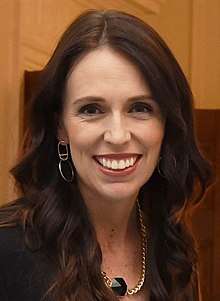
_-_Global_Citizen_Festival_Hamburg_04.jpg)
_(cropped).jpg)
.jpg)

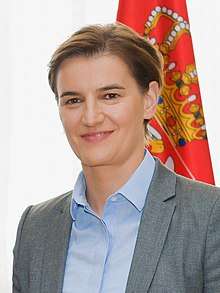
.jpg)

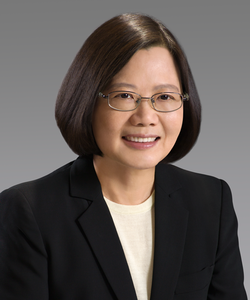

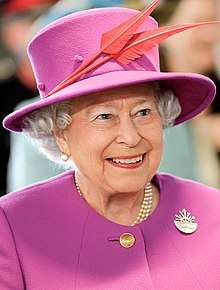
.jpg)
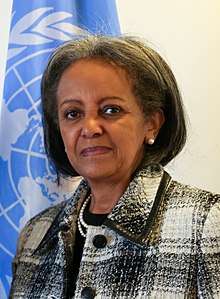
.jpg)
_VIII.jpg)
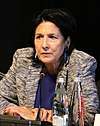
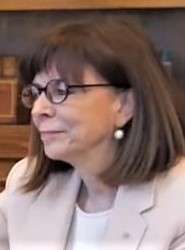
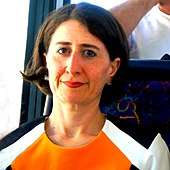
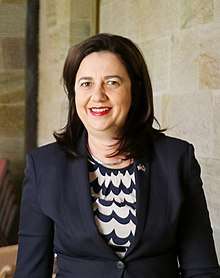
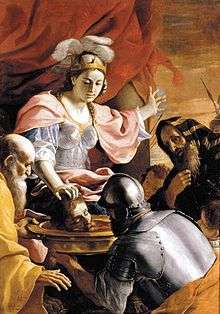
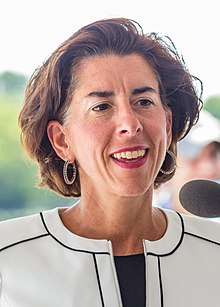


.jpg)
.jpg)
